
Veröffentlichungen des Verbundprojektes
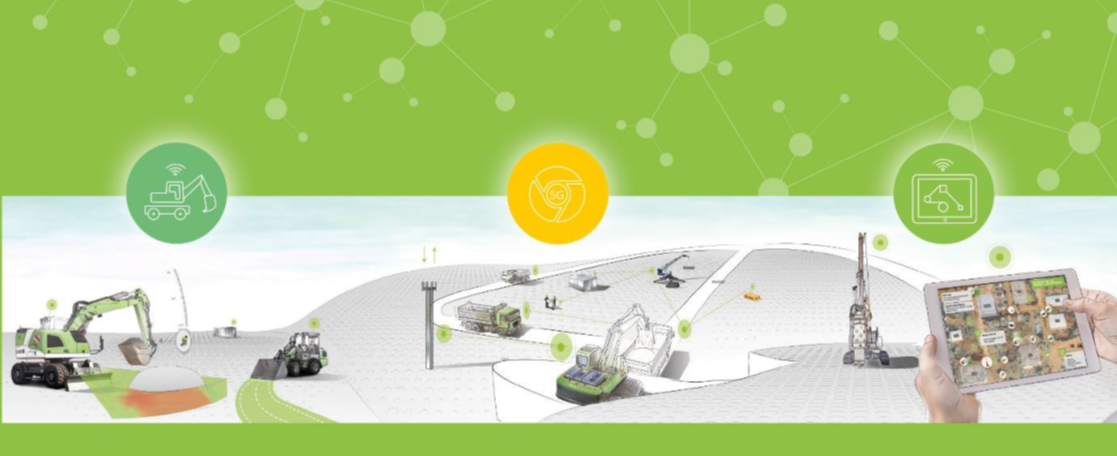
25 August
Überblick zu den Ergebnissen des Verbundprojektes
Nach 3,5 Jahren Projektlaufzeit war die Abschlussveranstaltung am 28. September 2022 in Hoyerswerda das praktische Highlight, aber die Ergebnisse des Projektes spiegeln sich auch in diversen Veröffentlichungen wider. Diese finden Sie hier im Folgenden nach den Themenschwerpunkten aufgelistet.
Viel Spaß beim Lesen und Informieren!
Eine gesammelte Darstellung aller Projektergebnisse finden Sie im Abschlussbericht des Verbundvorhabens. Diesen können Sie kostenlos und open access bei der TIB Hannover beziehen.
Klicken Sie dafür bitte auf folgenden Link:
Download Abschlussbericht Bauen 4.0
Gesamtevaluation
Hier sehen Sie die wichtigsten Beiträge zur Gesamtemevaluation.
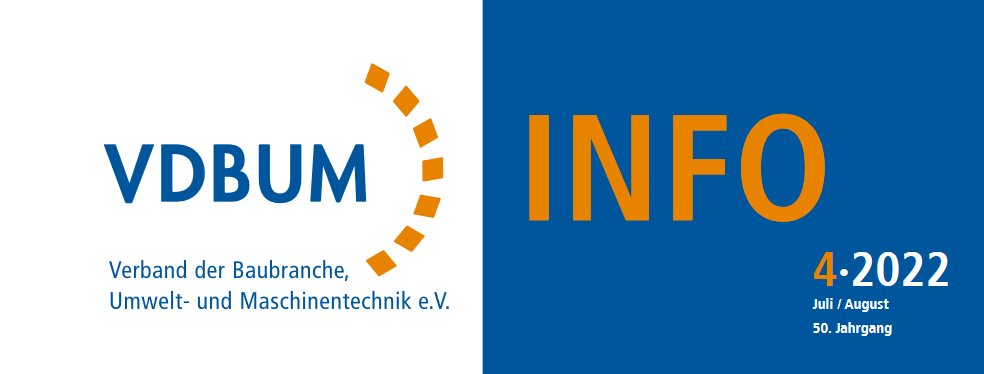
Bauen 4.0 - Forschung für die Baustelle der Zukunft
In VDBUMinfo 04-2022
Beck, B.; Waurich, V.; Jacob, R.; Kessler, S.; Fischer, A.; Cai, Z.; Schöberl, M.
2022, VDBUMinfo
Der hohe Bedarf im Wohnungs- und Infrastrukturausbau stellt den Bausektor vor große Herausforderungen. Um die Produktivität und Effizienz trotz Fachkräftemangel zu steigern, ist die Weiterentwicklung der Maschinentechnologie und der Bauprozesse ein wichtiger Hebel.
Downloads & Links
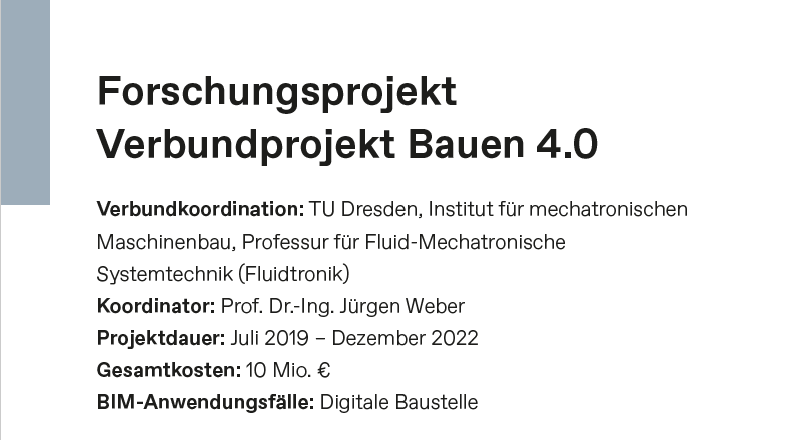
Forschungsprojekt Verbundprojekt Bauen 4.0
In "Hier steckt BIM drin! Sachsen"
Beck, B.; Weber, J.
2022, bsD Verlag
Die Baustelle der Zukunft steht im Fokus des Verbundprojekts „Bauen 4.0“. Gekennzeichnet ist sie durch eine durchgängige und schnittstellenübergreifende Digitalisierung von der Bauplanung und Baustellenlogistik über Vernetzungstechnologien bis hin zur Umsetzung diverser Automatisierungsstufen auf den Maschinen.
Downloads & Links
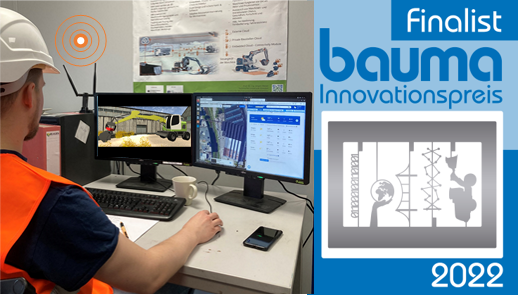
Site Execution System
Finalist Bauma Innovationspreis 2022
Beck, B.; Waurich, V.
2022, VDMAonline
Vernetzte und automatisierte Baumaschinen sind ein Schlüssel zu effizienteren Bauprozessen. Das Site Execution System (SES) ist der zentrale Baustein zur Aggregierung aller Maschinen- und Prozessdaten auf der Baustelle sowie der Orchestrierung automatisierter Baumaschinenflotten. Die SES-Plattform integriert Planungsdaten und verknüpft diese mit der Aufgabenbeschreibung für automatisierte Baumaschinen. Die Arbeitsergebnisse werden erfasst und den Aufgabenbeschreibungen sowie den zugrundeliegenden Planungsdaten zugeordnet. Bauleiter, Poliere und die MTA können die Baustelle in Echtzeit überwachen und Bauprozesse koordinieren.
Downloads & Links
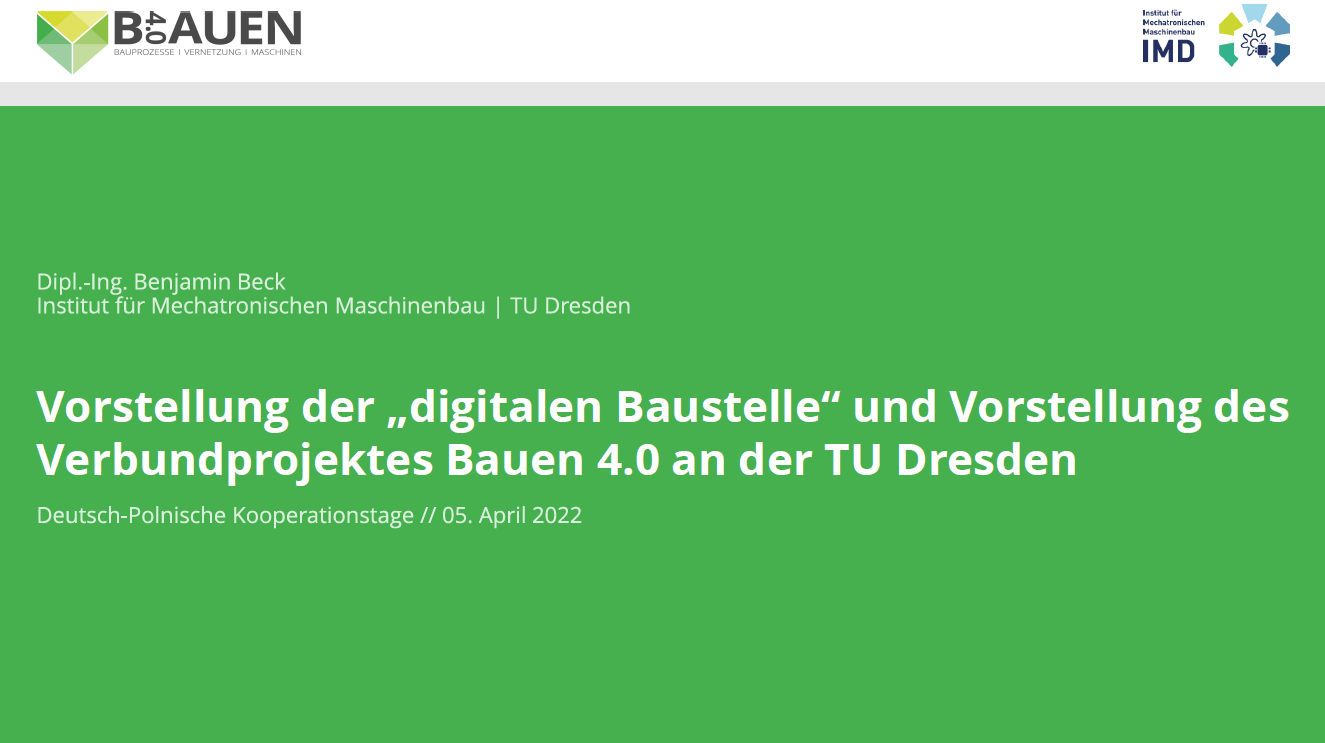
Vorstellung der „digitalen Baustelle“ und Vorstellung des Verbundprojektes Bauen 4.0 an der TU Dresden
Deutsch-polnische Kooperationstage im Bereich Digitalisierung der Baubranche 2022
Beck, B.
2022, Dreberis
Im Auftrag des Bundesministeriums für Wirtschaft und Klimaschutz (BMWK) organisierte DREBERIS im Zeitraum vom 05.04.2022 bis zum 07.04.2022 eine digitale Informationsreise für polnische Vertreter der Bauwirtschaft nach Deutschland. Es handelte sich dabei um eine projektbezogene Fördermaßnahme und wurde im Rahmen des Markterschließungsprogramms für KMU durchgeführt. Ursprünglich sollte die digitale Baustelle in Dresden live besucht werden. Aufgrund der Corona Pandemie fanden mehrere digitale Events statt, bei dem das Verbundprojekt Bauen 4.0 vorgestellt wurde.
Downloads & Links
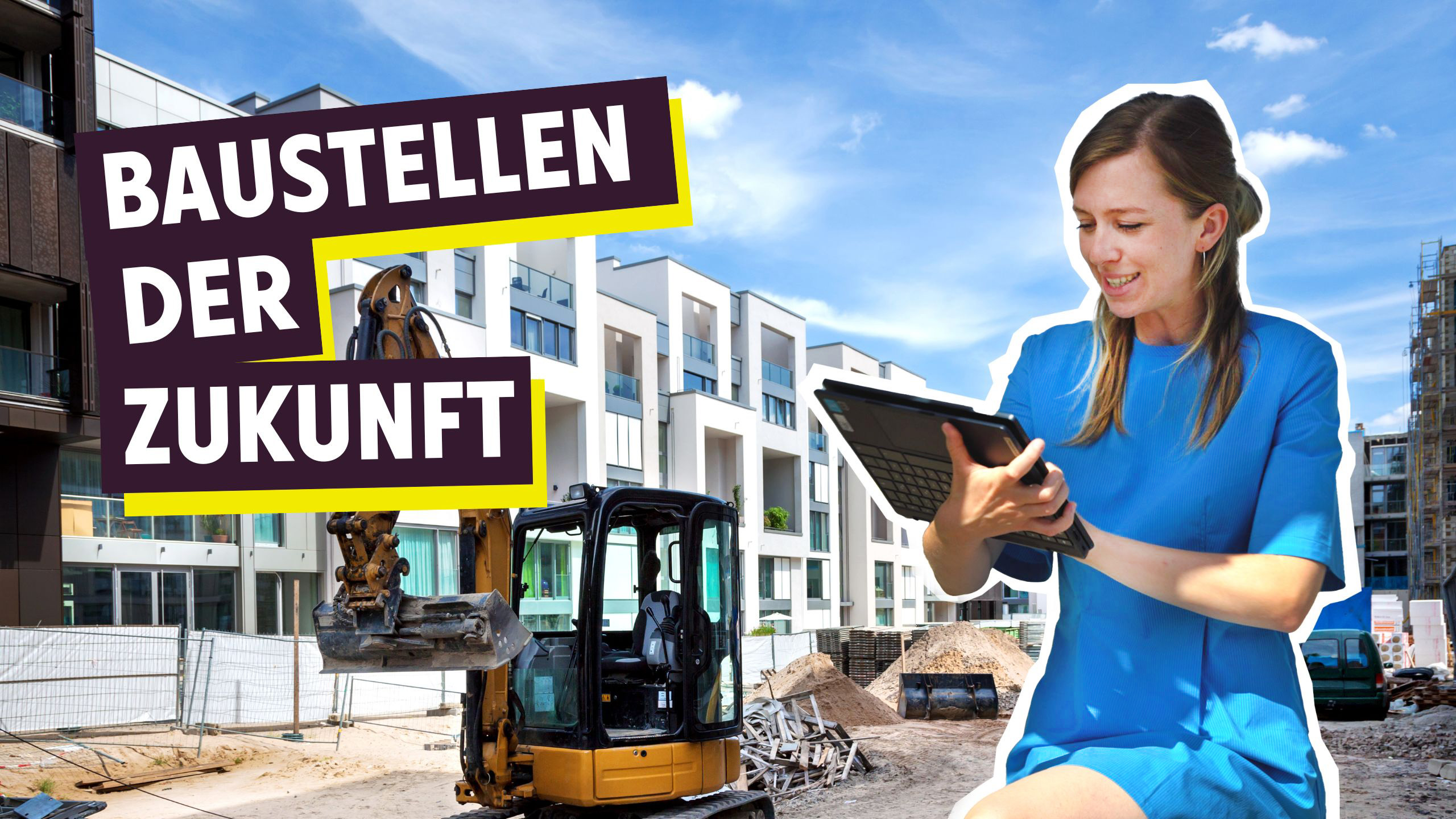
Baustelle der Zukunft: Bagger-Simulator in Reallife!
InnoPulsLab
2022, Youtube
Im aktuellen Film besuchen Ryan und unsere neue Moderatorin Caro das Forschungsprojekt Bauen 4.0 ☝️ Denn – gerade wird überall gebaut...
Wir haben unsfür euch gefragt: Wie läuft das heutzutage eigentlich so ab auf der Baustelle, wie modern und digital ist die Baubranche und wie attraktiv ist sie als Arbeitsplatz❓
Dazu besucht unser Moderatorenteam das Forschungsteam von Bauen 4.0 an der Technischen Universität Dresden, die zusammen mit einer ganzen Organisation von über 20 Firmen die komplette Baubranche revolutionieren wollen. Dazu entwickeln sie leistungsfähige, innovative und flexible Maschinen sowie Kommunikationstechnologien, um so alle Arbeitskräfte durch Digitalisierung und intelligente Automatisierung auf einer Baustelle zu unterstützen. Dazu tüfteln sie besonders an der Effizienz und Produktivitätssteigerung von Bauprozessen allgemein, und zwar durch die Vernetzung und Kommunikation mobiler Maschinen – damit jeder auf der Baustelle zu jedem Zeitpunkt weiß, wo der Hammer hängt und der Bagger baggert! Das nennen wir mal eine höhere Ordnung!
Schaut euch das Reallife-Game der Baustelle der Zukunft mit uns an. Denn: Wer braucht schon kleine Spielzeuge, wenn er richtige Bagger steuern kann💯?
Downloads & Links
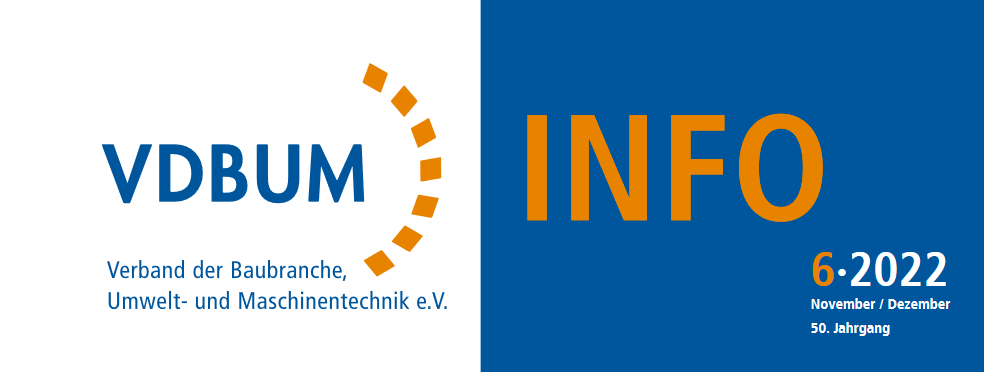
Auf der Baustelle angekommen - Verbundprojekt Bauen 4.0 veröffentlicht Abschlussbroschüre
In VDBUMinfo 06-2022
Lübberding, W.
2022, VDBUMinfo
200 Teilnehmende haben sich Ende September auf dem Außengelände der Versorgungsbetriebe Hoyerswerda über die Ergebnisse von drei Jahren Forschungsarbeit im Verbundprojekt Bauen 4.0 informiert.
Downloads & Links

Bauen 4.0 - Future of Construction Site
Vodafone
2022, Hoyerswerda
Zum Abschlussevent am 28.09.2022 war Vodafone zu Besuch und hat ein spannendes Video über die dort gezeigten Bauen 4.0 und Forschungsfeld Lausitz Lösungen gedreht.
Video
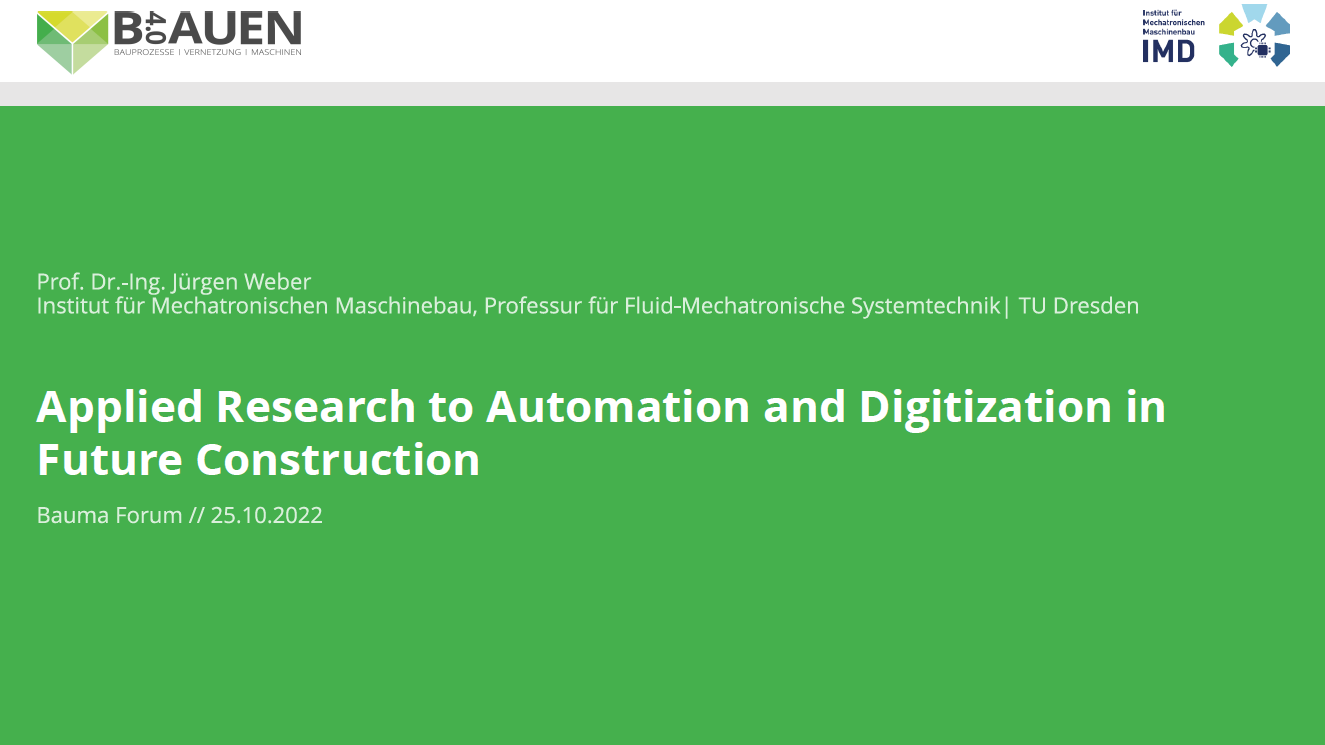
Applied Research to Automation and Digitization in Future Construction
Vortrag auf dem bauma Forum 2022
Weber, J.
2022, München Deutschland
Während der bauma 2022 findet begleitend das Forum statt - Eine Bühne für den Wissensaustausch. Bauen 4.0 war mit 2 Vorträgen dabei! Außerdem gab es im Vorfeld eine Webinarreihe.
Downloads & Links
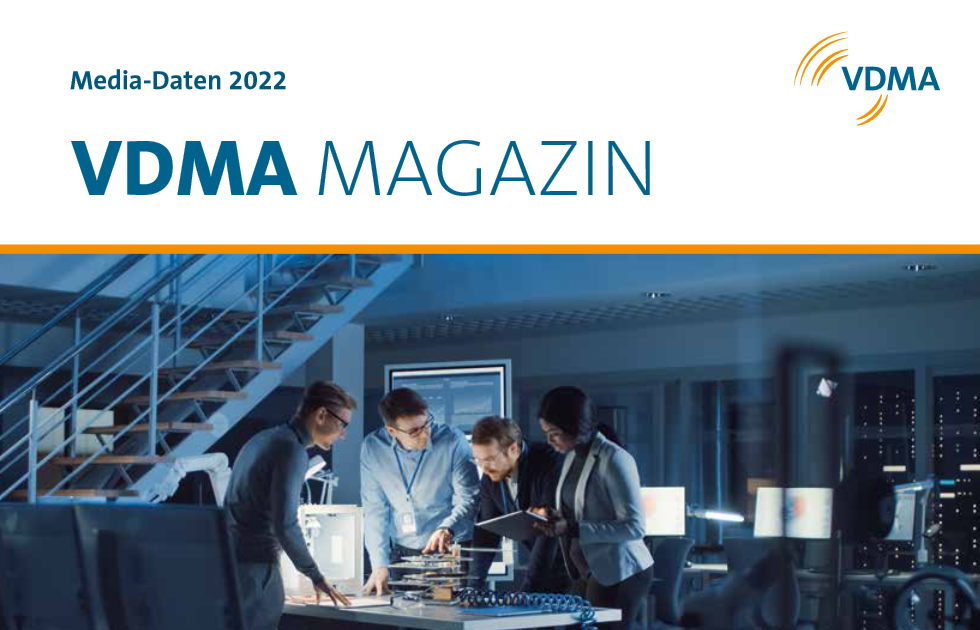
Europaweit vernetzen!
In VDMA Magazin 09/10 2022
Weber, J.
2022, VDMA Magazin
Das Baugewerbe verzeichnet nur geringe Produktivitätssteigerungen. Wie können Baumaschinenhersteller gegensteuern, um wettbewerbsfähig zu bleiben? Dringend notwendig sind etwa automatisierte Baumaschinen und - prozesse sowie die Vernetzung aller Akteure – nicht nur in Deutschland, sondern europaweit.
Downloads & Links
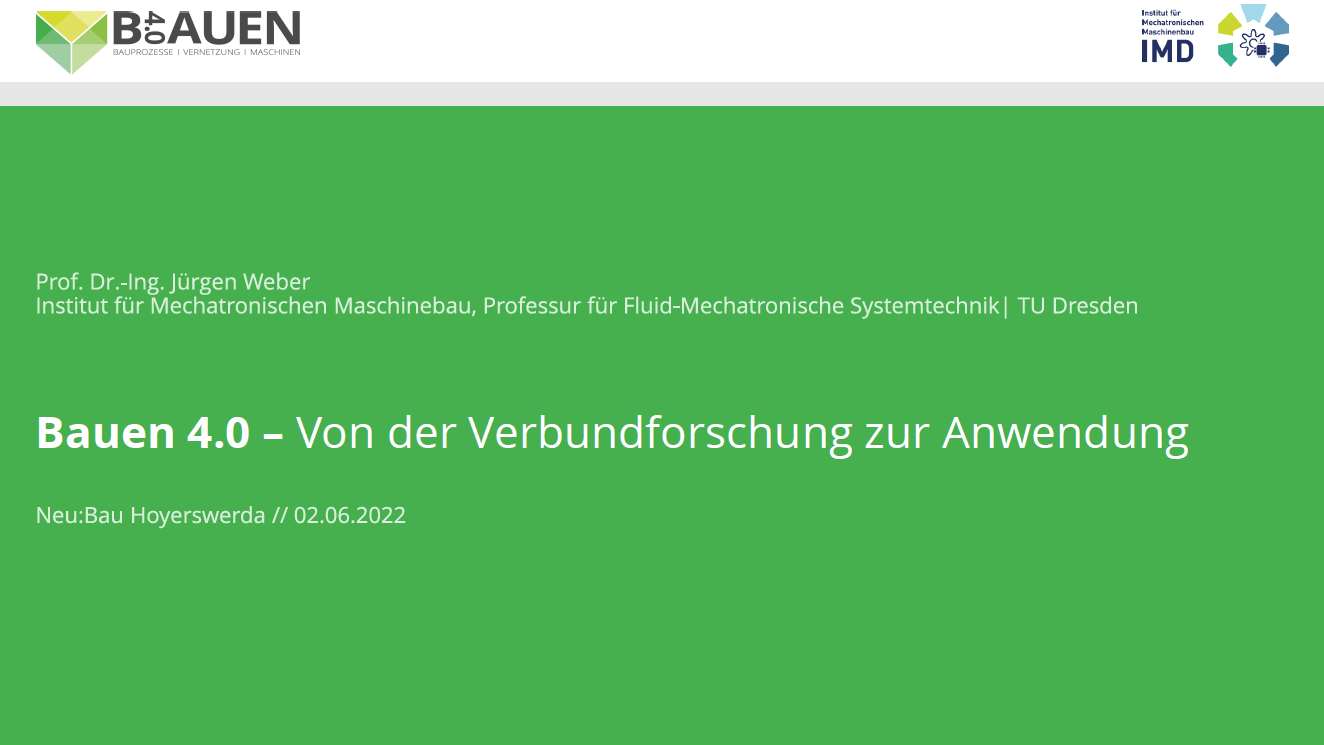
Von der Verbundforschung zur Anwendung
Vortrag im Rahmen der Tagung Neu:Bau22
Weber, J.
2022, Hoyerswerda
Die Lautech ist betreibt ein Technologiezentrum in Hoyerswerda, welches auch das zu Hause der Bauen 4.0 Mitarbeiter währedn der Vorbereitungsphase des Abschlusseventes war. Darüberhinaus ist die Lautech in diverse FuE Projekte im Themenbereich Bauen, speziell serielle Sanierung, inmvolviert und richtet deshalb jedes Jahr die Tagung Neu:Bau aus.
Downloads & Links
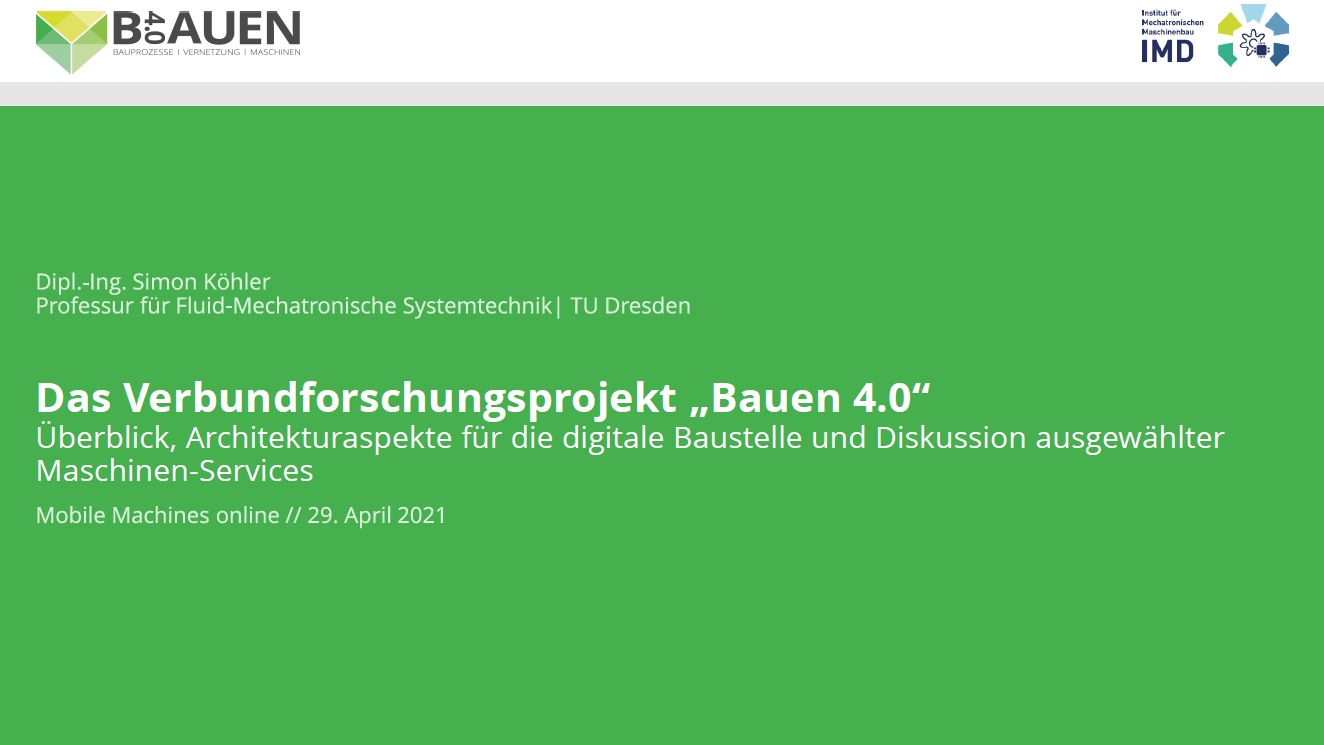
Das Verbundforschungsprojekt „Bauen 4.0“ - Überblick , Architekturaspekte für die digitale Baustelle und Diskussion ausgewählter Maschinen Services
Mobile Machines - Automatisierung und Konnektivität für Off-Highway Fahrzeuge
Köhler, S.
2021, Online
Präsentation ausgewählter Ergebnisse insbesondere im Themenschwerpunkt Maschinen bezogen auf Vernetzungsaspekte und deren Einbindung im Gesamtkontext
Downloads & Links
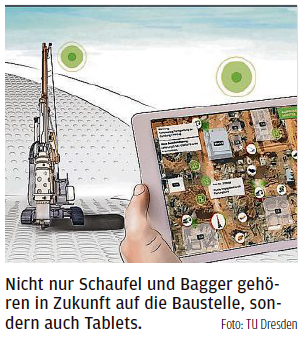
Die Baustelle der Zukunft
Die Exzellenzuniversität in Sachsen - Technische Universität Dresden - Eine Beilage in der sächsischen Zeitung
Mundus, J.
2021, Dresden Deutschland
Im Verbundprojekt „Bauen 4.0“ denken Ingenieure Bauabläufe neu. Maschinen und Menschen arbeiten künftig vernetzt miteinander. Das spart Zeit und wichtige Ressourcen.
Downloads & Links
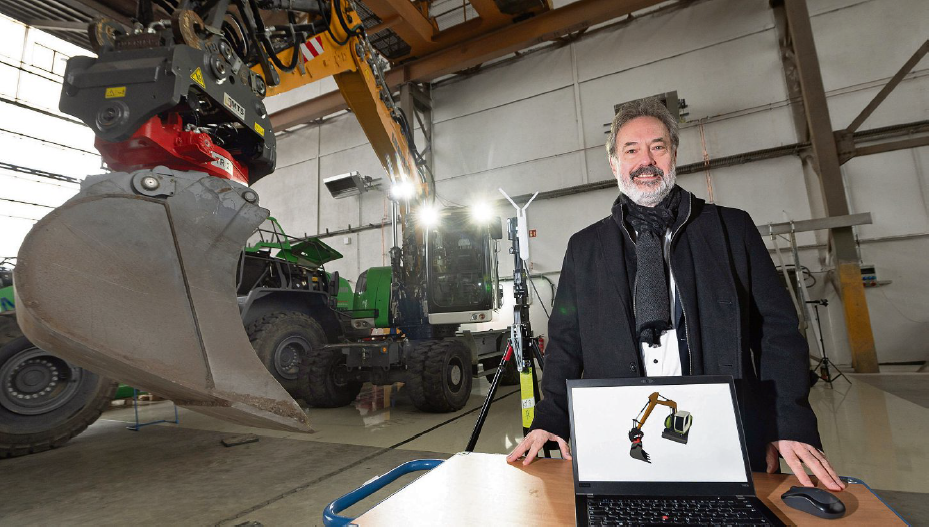
Dieser Bagger baggert selbst
Sächsische Zeitung
Mundus, J.
2021, Dresden
In diesem Moment ist Benjamin Beck für somanches Kind ein Held. Mit geübten Griffen an Hebeln und Knöpfen sorgt der Mann im Führerhaus dafür, dass sich die riesige Schaufel des Baggers bewegt. Stück für Stück ruckt sie in einer großen Halle der TU Dresden in die richtige Position fürs Foto.
Downloads & Links

Mit Bauen 4.0 zur digitalisierten Baustelle
In BauPortal
Weber, J.; Kessler,S.; Beck, B.; Jacob, R.; Weise, C.
2021
Unterschiedliche Akteure, dynamische Abläufe und eine heterogene Technik stellen Herausforderungen für die Digitalisierung von Bauprozessen dar. In dem vom Bundesministerium für Bildung und Forschung (BMBF) geförderten Verbundprojekt „Bauen 4.0“ arbeiten 30 Projektpartner an digitalen Innovationen für die Baustelle der Zukunft.
Downloads & Links & Links
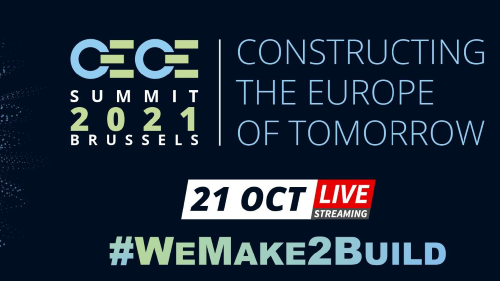
The Joint research project „ Bauen 4.0“ - Overview, development status, demos and outlook
CECE Summit
Weber, Jürgen
2021, Brüssel Belgien
Eine wichtige europäische Plattform stellt der europäische Baumaschinenverband CECE mit seinem Summit dar. Auch hier war Bauen 4.0 vertreten.
Downloads & Links
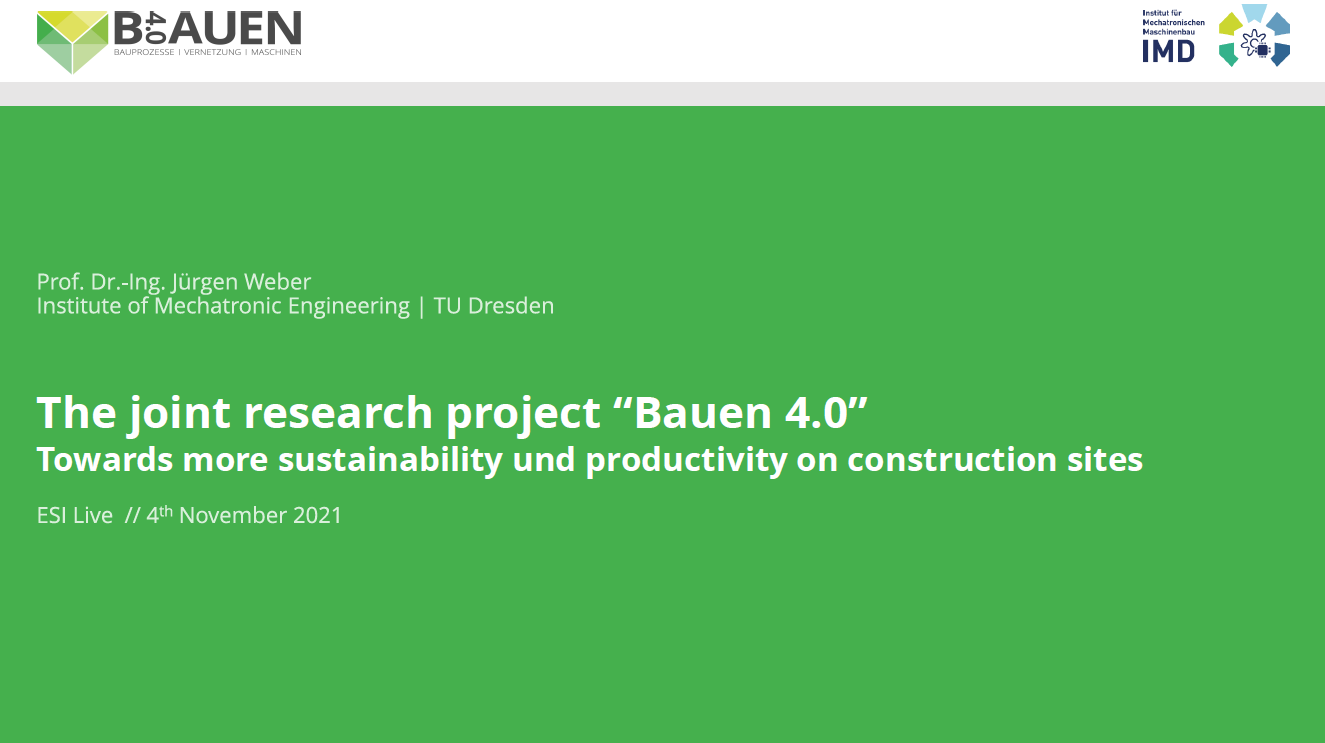
The joint research project “ Bauen 4.0” - Towards more sustainability und productivity on construction sites
In ESI Live
Weber, Jürgen
2021, Online
Unser Projektpartner ESI ITI veranstaltete eine Virtuelle Konferenz zur der Prof. Weber einen Einblick in unser gemeinsames Forschunsgprojekt gab.
Downloads & Links
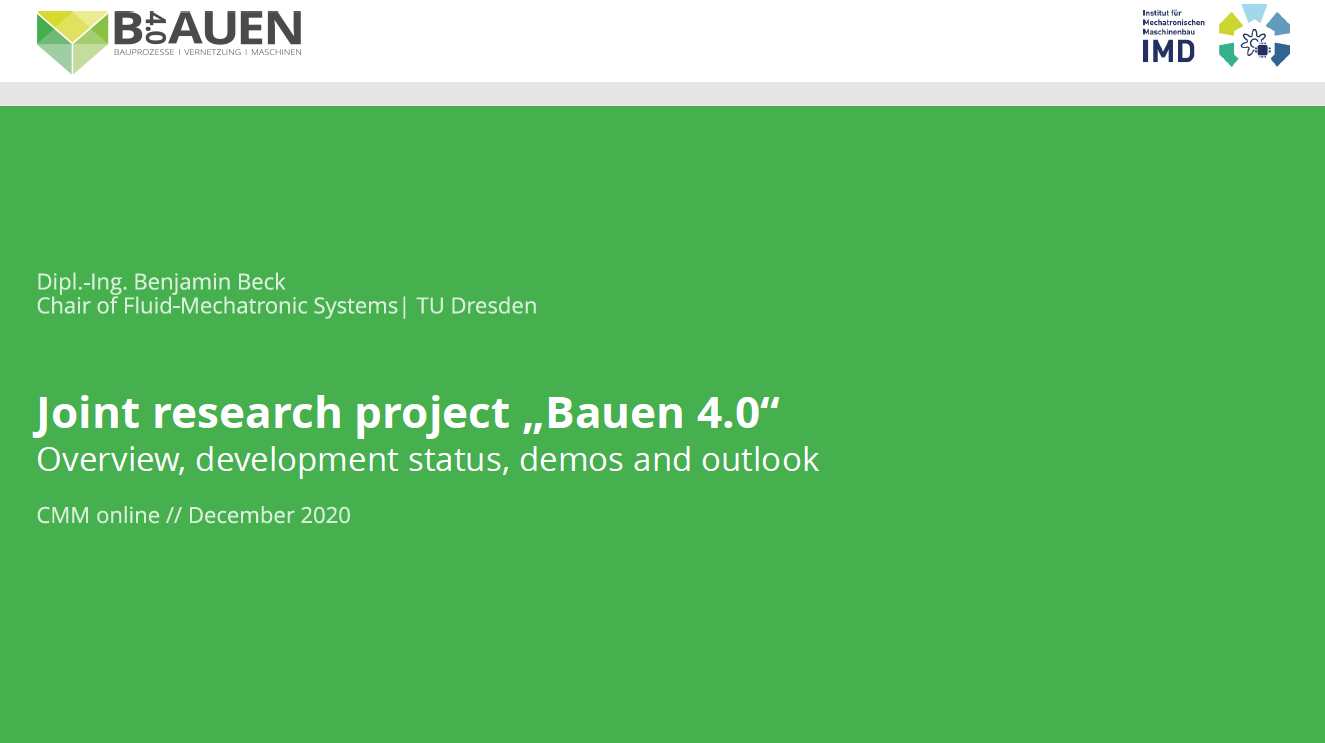
Joint research project „Bauen 4.0“ - Overview, development status, demos and outlook
CMM - Connected mobile Machines & Mobility
Beck, B.
2020, Hannover Deutschland
Ein Überblick zum Stand der Arbeiten des Verbundprojektes auf der CMM Tagung.
Downloads & Links

Current Research and Developments for Civil Engineering in Germany
Current Trends in Civil & Structural Engineering 5 (1)
Schöberl, M.; Cai, Z.; Fischer, A.; Kessler, S.
2020, Iris Publishers
Productivity of the construction industry stagnated in the recent decades [1] while other industries’ productivities were on the rise. Multiple differentiating factors between the construction and other industries are held accountable for this development.
Downloads & Links
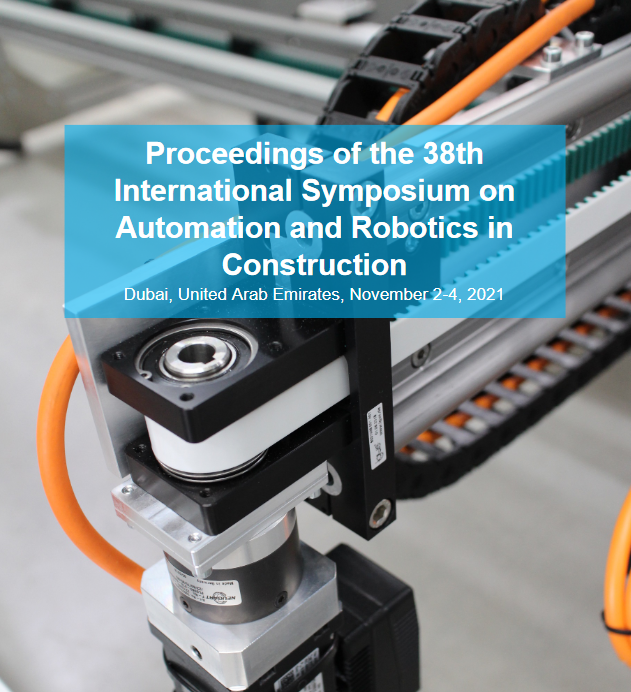
Towards a Construction Site Control System – Task Management in Construction Operations and Intralogistics.
38th International Symposium on Automation and Robotics in Construction (ISARC 2021)
Schöberl, M.; Bartmann, D.; Kessler, S.; Fottner, J.
2021, Dubai United Arab Emirates
The operation of automated construction equipment and autonomous construction robots depends on contextual information regarding the job to be carried out. Therefore, robots as well as equipment require a task-based construction site control system. Such a system also provides some advantages for construction managers.
Downloads & Links
Gesamtevaluation
Hier sehen Sie die wichtigsten Beiträge zur Gesamtemevaluation.
Bauen 4.0 - Forschung für die Baustelle der Zukunft
In VDBUMinfo 04-2022
Beck, B.; Waurich, V.; Jacob, R.; Kessler, S.; Fischer, A.; Cai, Z.; Schöberl, M.
2022, VDBUMinfo
Der hohe Bedarf im Wohnungs- und Infrastrukturausbau stellt den Bausektor vor große Herausforderungen. Um die Produktivität und Effizienz trotz Fachkräftemangel zu steigern, ist die Weiterentwicklung der Maschinentechnologie und der Bauprozesse ein wichtiger Hebel.
Downloads & Links

Forschungsprojekt Verbundprojekt Bauen 4.0
In "Hier steckt BIM drin! Sachsen"
Beck, B.; Weber, J.
2022, bsD Verlag
Die Baustelle der Zukunft steht im Fokus des Verbundprojekts „Bauen 4.0“. Gekennzeichnet ist sie durch eine durchgängige und schnittstellenübergreifende Digitalisierung von der Bauplanung und Baustellenlogistik über Vernetzungstechnologien bis hin zur Umsetzung diverser Automatisierungsstufen auf den Maschinen.
Downloads & Links

Site Execution System
Finalist Bauma Innovationspreis 2022
Beck, B.; Waurich, V.
2022, VDMAonline
Vernetzte und automatisierte Baumaschinen sind ein Schlüssel zu effizienteren Bauprozessen. Das Site Execution System (SES) ist der zentrale Baustein zur Aggregierung aller Maschinen- und Prozessdaten auf der Baustelle sowie der Orchestrierung automatisierter Baumaschinenflotten. Die SES-Plattform integriert Planungsdaten und verknüpft diese mit der Aufgabenbeschreibung für automatisierte Baumaschinen. Die Arbeitsergebnisse werden erfasst und den Aufgabenbeschreibungen sowie den zugrundeliegenden Planungsdaten zugeordnet. Bauleiter, Poliere und die MTA können die Baustelle in Echtzeit überwachen und Bauprozesse koordinieren.
Downloads & Links

Vorstellung der „digitalen Baustelle“ und Vorstellung des Verbundprojektes Bauen 4.0 an der TU Dresden
Deutsch-polnische Kooperationstage im Bereich Digitalisierung der Baubranche 2022
Beck, B.
2022, Dreberis
Im Auftrag des Bundesministeriums für Wirtschaft und Klimaschutz (BMWK) organisierte DREBERIS im Zeitraum vom 05.04.2022 bis zum 07.04.2022 eine digitale Informationsreise für polnische Vertreter der Bauwirtschaft nach Deutschland. Es handelte sich dabei um eine projektbezogene Fördermaßnahme und wurde im Rahmen des Markterschließungsprogramms für KMU durchgeführt. Ursprünglich sollte die digitale Baustelle in Dresden live besucht werden. Aufgrund der Corona Pandemie fanden mehrere digitale Events statt, bei dem das Verbundprojekt Bauen 4.0 vorgestellt wurde.
Downloads & Links

Baustelle der Zukunft: Bagger-Simulator in Reallife!
InnoPulsLab
2022, Youtube
Im aktuellen Film besuchen Ryan und unsere neue Moderatorin Caro das Forschungsprojekt Bauen 4.0 ☝️ Denn – gerade wird überall gebaut...
Wir haben unsfür euch gefragt: Wie läuft das heutzutage eigentlich so ab auf der Baustelle, wie modern und digital ist die Baubranche und wie attraktiv ist sie als Arbeitsplatz❓
Dazu besucht unser Moderatorenteam das Forschungsteam von Bauen 4.0 an der Technischen Universität Dresden, die zusammen mit einer ganzen Organisation von über 20 Firmen die komplette Baubranche revolutionieren wollen. Dazu entwickeln sie leistungsfähige, innovative und flexible Maschinen sowie Kommunikationstechnologien, um so alle Arbeitskräfte durch Digitalisierung und intelligente Automatisierung auf einer Baustelle zu unterstützen. Dazu tüfteln sie besonders an der Effizienz und Produktivitätssteigerung von Bauprozessen allgemein, und zwar durch die Vernetzung und Kommunikation mobiler Maschinen – damit jeder auf der Baustelle zu jedem Zeitpunkt weiß, wo der Hammer hängt und der Bagger baggert! Das nennen wir mal eine höhere Ordnung!
Schaut euch das Reallife-Game der Baustelle der Zukunft mit uns an. Denn: Wer braucht schon kleine Spielzeuge, wenn er richtige Bagger steuern kann💯?
Downloads & Links
Auf der Baustelle angekommen - Verbundprojekt Bauen 4.0 veröffentlicht Abschlussbroschüre
In VDBUMinfo 06-2022
Lübberding, W.
2022, VDBUMinfo
200 Teilnehmende haben sich Ende September auf dem Außengelände der Versorgungsbetriebe Hoyerswerda über die Ergebnisse von drei Jahren Forschungsarbeit im Verbundprojekt Bauen 4.0 informiert.
Downloads & Links
Bauen 4.0 - Future of Construction Site
Vodafone
2022, Hoyerswerda
Zum Abschlussevent am 28.09.2022 war Vodafone zu Besuch und hat ein spannendes Video über die dort gezeigten Bauen 4.0 und Forschungsfeld Lausitz Lösungen gedreht.
Video

Applied Research to Automation and Digitization in Future Construction
Vortrag auf dem bauma Forum 2022
Weber, J.
2022, München Deutschland
Während der bauma 2022 findet begleitend das Forum statt - Eine Bühne für den Wissensaustausch. Bauen 4.0 war mit 2 Vorträgen dabei! Außerdem gab es im Vorfeld eine Webinarreihe.
Downloads & Links
Europaweit vernetzen!
In VDMA Magazin 09/10 2022
Weber, J.
2022, VDMA Magazin
Das Baugewerbe verzeichnet nur geringe Produktivitätssteigerungen. Wie können Baumaschinenhersteller gegensteuern, um wettbewerbsfähig zu bleiben? Dringend notwendig sind etwa automatisierte Baumaschinen und - prozesse sowie die Vernetzung aller Akteure – nicht nur in Deutschland, sondern europaweit.
Downloads & Links

Von der Verbundforschung zur Anwendung
Vortrag im Rahmen der Tagung Neu:Bau22
Weber, J.
2022, Hoyerswerda
Die Lautech ist betreibt ein Technologiezentrum in Hoyerswerda, welches auch das zu Hause der Bauen 4.0 Mitarbeiter währedn der Vorbereitungsphase des Abschlusseventes war. Darüberhinaus ist die Lautech in diverse FuE Projekte im Themenbereich Bauen, speziell serielle Sanierung, inmvolviert und richtet deshalb jedes Jahr die Tagung Neu:Bau aus.
Downloads & Links

Das Verbundforschungsprojekt „Bauen 4.0“ - Überblick , Architekturaspekte für die digitale Baustelle und Diskussion ausgewählter Maschinen Services
Mobile Machines - Automatisierung und Konnektivität für Off-Highway Fahrzeuge
Köhler, S.
2021, Online
Präsentation ausgewählter Ergebnisse insbesondere im Themenschwerpunkt Maschinen bezogen auf Vernetzungsaspekte und deren Einbindung im Gesamtkontext
Downloads & Links

Die Baustelle der Zukunft
Die Exzellenzuniversität in Sachsen - Technische Universität Dresden - Eine Beilage in der sächsischen Zeitung
Mundus, J.
2021, Dresden Deutschland
Im Verbundprojekt „Bauen 4.0“ denken Ingenieure Bauabläufe neu. Maschinen und Menschen arbeiten künftig vernetzt miteinander. Das spart Zeit und wichtige Ressourcen.
Downloads & Links

Dieser Bagger baggert selbst
Sächsische Zeitung
Mundus, J.
2021, Dresden
In diesem Moment ist Benjamin Beck für somanches Kind ein Held. Mit geübten Griffen an Hebeln und Knöpfen sorgt der Mann im Führerhaus dafür, dass sich die riesige Schaufel des Baggers bewegt. Stück für Stück ruckt sie in einer großen Halle der TU Dresden in die richtige Position fürs Foto.
Downloads & Links

Mit Bauen 4.0 zur digitalisierten Baustelle
In BauPortal
Weber, J.; Kessler,S.; Beck, B.; Jacob, R.; Weise, C.
2021
Unterschiedliche Akteure, dynamische Abläufe und eine heterogene Technik stellen Herausforderungen für die Digitalisierung von Bauprozessen dar. In dem vom Bundesministerium für Bildung und Forschung (BMBF) geförderten Verbundprojekt „Bauen 4.0“ arbeiten 30 Projektpartner an digitalen Innovationen für die Baustelle der Zukunft.
Downloads & Links & Links

The Joint research project „ Bauen 4.0“ - Overview, development status, demos and outlook
CECE Summit
Weber, Jürgen
2021, Brüssel Belgien
Eine wichtige europäische Plattform stellt der europäische Baumaschinenverband CECE mit seinem Summit dar. Auch hier war Bauen 4.0 vertreten.
Downloads & Links

The joint research project “ Bauen 4.0” - Towards more sustainability und productivity on construction sites
In ESI Live
Weber, Jürgen
2021, Online
Unser Projektpartner ESI ITI veranstaltete eine Virtuelle Konferenz zur der Prof. Weber einen Einblick in unser gemeinsames Forschunsgprojekt gab.
Downloads & Links

Joint research project „Bauen 4.0“ - Overview, development status, demos and outlook
CMM - Connected mobile Machines & Mobility
Beck, B.
2020, Hannover Deutschland
Ein Überblick zum Stand der Arbeiten des Verbundprojektes auf der CMM Tagung.
Downloads & Links
Current Research and Developments for Civil Engineering in Germany
Current Trends in Civil & Structural Engineering 5 (1)
Schöberl, M.; Cai, Z.; Fischer, A.; Kessler, S.
2020, Iris Publishers
Productivity of the construction industry stagnated in the recent decades [1] while other industries’ productivities were on the rise. Multiple differentiating factors between the construction and other industries are held accountable for this development.
Downloads & Links
Towards a Construction Site Control System – Task Management in Construction Operations and Intralogistics.
38th International Symposium on Automation and Robotics in Construction (ISARC 2021)
Schöberl, M.; Bartmann, D.; Kessler, S.; Fottner, J.
2021, Dubai United Arab Emirates
The operation of automated construction equipment and autonomous construction robots depends on contextual information regarding the job to be carried out. Therefore, robots as well as equipment require a task-based construction site control system. Such a system also provides some advantages for construction managers.
Downloads & Links
Automatisierte, vernetzte Maschinen
Hier sehen Sie die wichtigsten Beiträge zum Thema automatisierte, vernetzte Maschinen.

Availability, security and interoperability of machine data in the connected construction site
Vortrag auf dem Bauma Forum 2022
Beck, B.
2022, München Deutschland
Während der bauma 2022 findet begleitend das Forum statt - Eine Bühne für den Wissensaustausch. Bauen 4.0 war mit 2 Vorträgen dabei! Außerdem gab es im Vorfeld eine Webinarreihe.
Downloads & Links
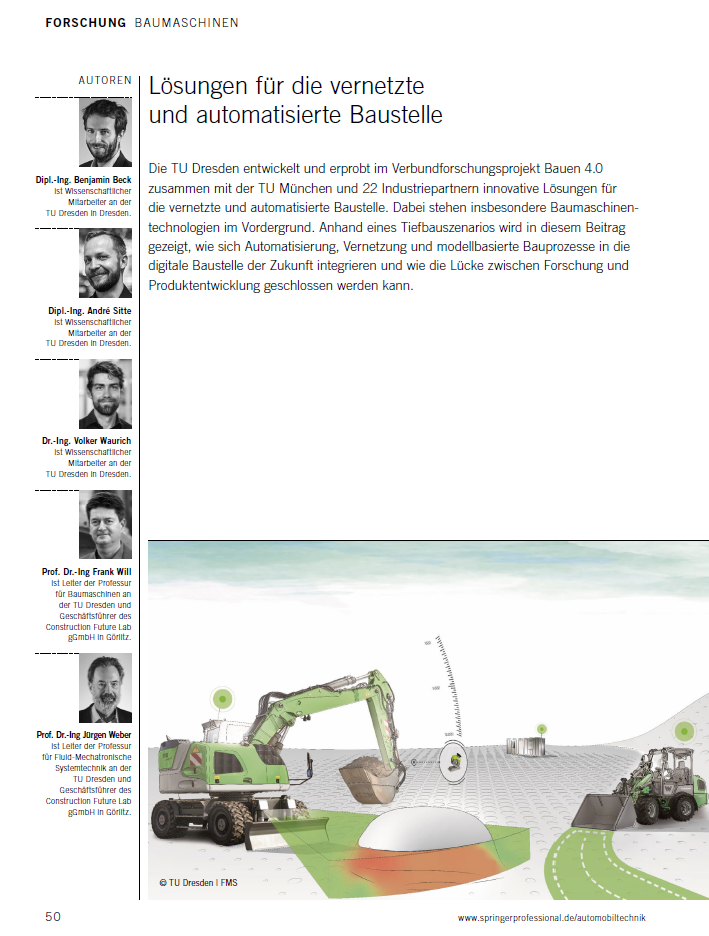
Lösungen für die vernetzte und automatisierte Baustelle
ATZ heavyduty 15, pages 48–53 (2022)
Beck, B.; Sitte, A.; Waurich, V.; Will, F.; Weber, J.
2022, ATZ heavyduty
Die TU Dresden entwickelt und erprobt im Verbundforschungsprojekt Bauen 4.0 zusammen mit der TU München und 22 Industriepartnern innovative Lösungen für die vernetzte und automatisierte Baustelle. Dabei stehen insbesondere Baumaschinentechnologien im Vordergrund. Anhand eines Tiefbauszenarios wird in diesem Beitrag gezeigt, wie sich Automatisierung, Vernetzung und modellbasierte Bauprozesse in die digitale Baustelle der Zukunft integrieren und wie die Lücke zwischen Forschung und Produktentwicklung geschlossen werden kann.
Downloads & Links
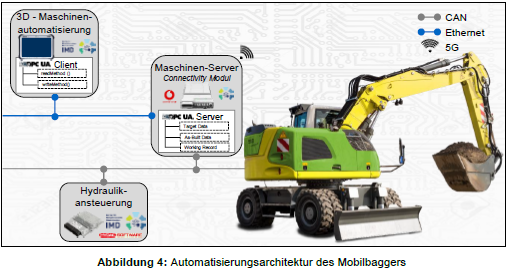
Bauen 4.0: Vernetzter, automatisierter Tiefbau am Beispiel Mobilbagger
9. Fachtagung Baumaschinentechnik
Köhler, S.; Waurich, V.; Ritz, D.;Beck, B.; Weber, J.; Will, F.
2022, Dresden
Die Betrachtung des Status Quo der Digitalisierung im Bausektor zeigt, dass viele Aspekte des digitalen Bauens bereits umgesetzt sind. Diese Lösungen sind jedoch häufig unzureichend kompatibel zueinander. Im Rahmen des Verbundforschungsprojektes Bauen 4.0 wurde daher ein an ISO 15143-1 angelehnter Systemarchitekturansatz entwickelt, bei dem die Bauausführung und die mobilen Arbeitsmaschinen im Fokus liegen.
Downloads & Links
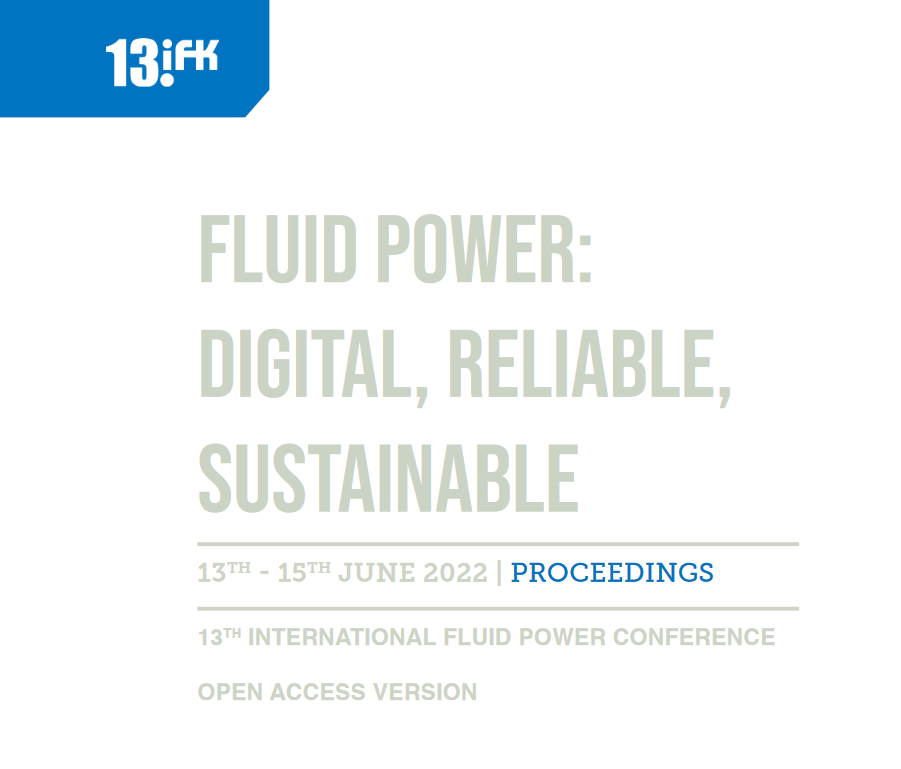
Integration of fault detection and diagnosis methods into OPC UA for mobile machinery
13th International Fluid Power Conference
Köhler, S.; Weber, J.
2022, Aachen Deutschland
In the construction industry, so-called site information systems are responsible for consistent end-to-end data utilization by connecting relevant stakeholders, which shall increase productivity and sustainability. This paper continues the work on OPC Unified Architecture (OPC UA) data models for mobile machinery and integrates a fault management system. The information model comprises two use cases, precisely machine supervision and machine maintenance. To demonstrate the functionality of the proposed solution, a Software-in-the-Loop Simulation including implemented OPC UA server and clients has been executed. The communication via OPC UA meets the identified requirements of the use cases.
Downloads & Links

On the qualification of common off-road hydraulic systems for upcoming automation
13th International Fluid Power Conference
Ritz, D.; Weber, J.
2022, Aachen Deutschland
This contribution will give a broad overview on automated earth moving machinery, especially on excavators. On the basis of a mobile excavator with state-of-the-art flow sharing system, an analysis of the system characteristics is carried out. The Main aspect of this contribution will be the subsystem controls of the hydraulic system. A suitable control strategy is derived from the architecture of the hydraulic system. Thereby, additional safety components like pipe burst and suction valves are analyzed regarding their influence on the system behavior. The developed control strategy is included into the software architecture. Finally, the model-based validation with a synthetic test cycle for multiple axis is used to show the functionality of the developed algorithms. The work of this contribution is part of the joint research project "Bauen 4.0".
Downloads & Links

The path to distributed hydraulic actuation - Model-based system design of enhanced mechatronic pilot systems
13th International Fluid Power Conference
Erhard, M.; Richter, S.; Roßmann, P.; Petzold, M.
2022, Aachen Deutschland
Excavators creating a planum or digging a trench without an operator on the machine – are automated machine functions the near future? THOMAS can answer this not alone, but our products can pave the way. Modern mechatronic pilot systems for decentralized axis control simplify interaction with the overall machine control by supporting the integration of assistance and automation systems. With the electro-hydraulic actuator, an intelligent and simple configurable component for closed-loop operation of directional control valves is available. Model-in-the-loop approaches lead to a robust and accurate controller design. Adaptation to different customer systems is taken into account both by the controller architecture and by supporting parameterization via self-adaptation. The integration of these functions thus maximizes customer benefits while leaving room for their own visions.
Downloads & Links
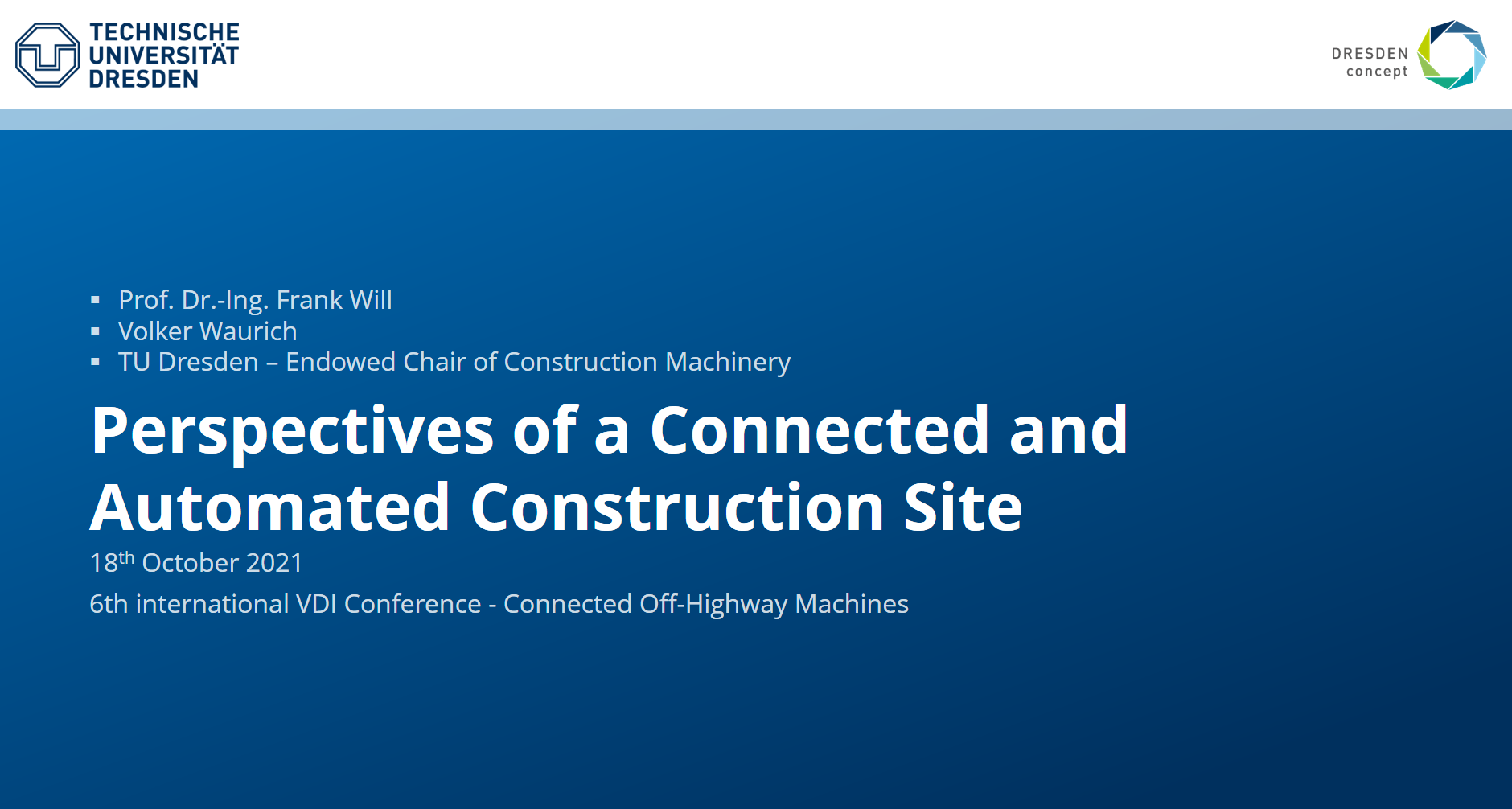
Perspectives of a Connected and Automated Construction Site
6th international VDI Conference - Connected Off-Highway Machines
Waurich, V.; Will, F.
2021, Online
...
Downloads & Links
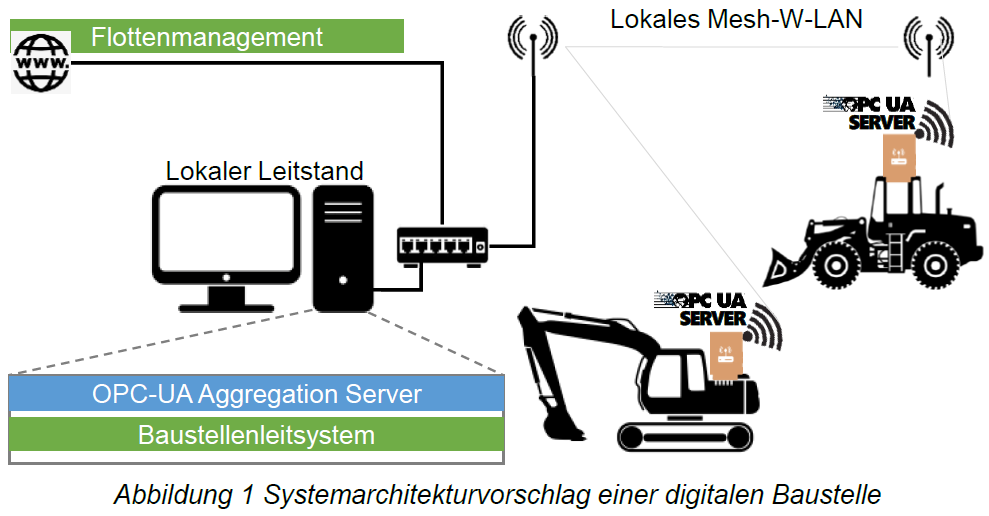
Netzwerkschnittstellen für mobile Arbeitsmaschinen im Kontext der digitalisierten Baustelle
8. Fachtagung Baumaschinentechnik
Köhler, S.; Waurich, V.; Ritz, D.; Beck, B.; Weber, J.; Will, F.
2020, Dresden Deutschland
Baustellen unterscheiden sich von der industriellen Fertigung durch ihr komplexeres Um-feld, ihrem Unikatcharakter (Losgröße1) und den vielen, stark heterogenen Akteuren sowie die fehlenden Standards und Schnittstellen zum Datenaustausch. Mit dem Einsatz digitaler Technologien beweist die industrielle Fertigung bereits heute erzielbare Mehrwehrte [1]. Eine einfache Übertragung auf Baustellenszenarien ist zwar nicht möglich, Teilaspekte las-sen sich jedoch anwenden.
Downloads & Links
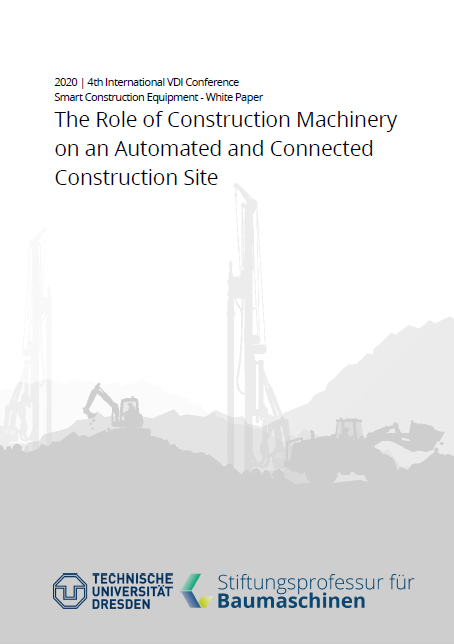
The Role of Construction Machinery on an Automated and Connected Construction Site
4th International VDI Conference Smart Construction Equipment - White Paper
Waurich, V.; Will, F.
2020
This white paper outlines the role of construction machinery in a construction process that is driven by model based life cycle management and digital information flow. The authors illustrate the role of machine automation and emphasize the importance of integrated data flow.
Downloads & Links
Automatisierte, vernetzte Maschinen
Hier sehen Sie die wichtigsten Beiträge zum Thema automatisierte, vernetzte Maschinen.

Availability, security and interoperability of machine data in the connected construction site
Vortrag auf dem Bauma Forum 2022
Beck, B.
2022, München Deutschland
Während der bauma 2022 findet begleitend das Forum statt - Eine Bühne für den Wissensaustausch. Bauen 4.0 war mit 2 Vorträgen dabei! Außerdem gab es im Vorfeld eine Webinarreihe.
Downloads & Links
Lösungen für die vernetzte und automatisierte Baustelle
ATZ heavyduty 15, pages 48–53 (2022)
Beck, B.; Sitte, A.; Waurich, V.; Will, F.; Weber, J.
2022, ATZ heavyduty
Die TU Dresden entwickelt und erprobt im Verbundforschungsprojekt Bauen 4.0 zusammen mit der TU München und 22 Industriepartnern innovative Lösungen für die vernetzte und automatisierte Baustelle. Dabei stehen insbesondere Baumaschinentechnologien im Vordergrund. Anhand eines Tiefbauszenarios wird in diesem Beitrag gezeigt, wie sich Automatisierung, Vernetzung und modellbasierte Bauprozesse in die digitale Baustelle der Zukunft integrieren und wie die Lücke zwischen Forschung und Produktentwicklung geschlossen werden kann.
Downloads & Links

Bauen 4.0: Vernetzter, automatisierter Tiefbau am Beispiel Mobilbagger
9. Fachtagung Baumaschinentechnik
Köhler, S.; Waurich, V.; Ritz, D.;Beck, B.; Weber, J.; Will, F.
2022, Dresden
Die Betrachtung des Status Quo der Digitalisierung im Bausektor zeigt, dass viele Aspekte des digitalen Bauens bereits umgesetzt sind. Diese Lösungen sind jedoch häufig unzureichend kompatibel zueinander. Im Rahmen des Verbundforschungsprojektes Bauen 4.0 wurde daher ein an ISO 15143-1 angelehnter Systemarchitekturansatz entwickelt, bei dem die Bauausführung und die mobilen Arbeitsmaschinen im Fokus liegen.
Downloads & Links
Integration of fault detection and diagnosis methods into OPC UA for mobile machinery
13th International Fluid Power Conference
Köhler, S.; Weber, J.
2022, Aachen Deutschland
In the construction industry, so-called site information systems are responsible for consistent end-to-end data utilization by connecting relevant stakeholders, which shall increase productivity and sustainability. This paper continues the work on OPC Unified Architecture (OPC UA) data models for mobile machinery and integrates a fault management system. The information model comprises two use cases, precisely machine supervision and machine maintenance. To demonstrate the functionality of the proposed solution, a Software-in-the-Loop Simulation including implemented OPC UA server and clients has been executed. The communication via OPC UA meets the identified requirements of the use cases.
Downloads & Links
On the qualification of common off-road hydraulic systems for upcoming automation
13th International Fluid Power Conference
Ritz, D.; Weber, J.
2022, Aachen Deutschland
This contribution will give a broad overview on automated earth moving machinery, especially on excavators. On the basis of a mobile excavator with state-of-the-art flow sharing system, an analysis of the system characteristics is carried out. The Main aspect of this contribution will be the subsystem controls of the hydraulic system. A suitable control strategy is derived from the architecture of the hydraulic system. Thereby, additional safety components like pipe burst and suction valves are analyzed regarding their influence on the system behavior. The developed control strategy is included into the software architecture. Finally, the model-based validation with a synthetic test cycle for multiple axis is used to show the functionality of the developed algorithms. The work of this contribution is part of the joint research project "Bauen 4.0".
Downloads & Links
The path to distributed hydraulic actuation - Model-based system design of enhanced mechatronic pilot systems
13th International Fluid Power Conference
Erhard, M.; Richter, S.; Roßmann, P.; Petzold, M.
2022, Aachen Deutschland
Excavators creating a planum or digging a trench without an operator on the machine – are automated machine functions the near future? THOMAS can answer this not alone, but our products can pave the way. Modern mechatronic pilot systems for decentralized axis control simplify interaction with the overall machine control by supporting the integration of assistance and automation systems. With the electro-hydraulic actuator, an intelligent and simple configurable component for closed-loop operation of directional control valves is available. Model-in-the-loop approaches lead to a robust and accurate controller design. Adaptation to different customer systems is taken into account both by the controller architecture and by supporting parameterization via self-adaptation. The integration of these functions thus maximizes customer benefits while leaving room for their own visions.
Downloads & Links
Perspectives of a Connected and Automated Construction Site
6th international VDI Conference - Connected Off-Highway Machines
Waurich, V.; Will, F.
2021, Online
...
Downloads & Links

Netzwerkschnittstellen für mobile Arbeitsmaschinen im Kontext der digitalisierten Baustelle
8. Fachtagung Baumaschinentechnik
Köhler, S.; Waurich, V.; Ritz, D.; Beck, B.; Weber, J.; Will, F.
2020, Dresden Deutschland
Baustellen unterscheiden sich von der industriellen Fertigung durch ihr komplexeres Um-feld, ihrem Unikatcharakter (Losgröße1) und den vielen, stark heterogenen Akteuren sowie die fehlenden Standards und Schnittstellen zum Datenaustausch. Mit dem Einsatz digitaler Technologien beweist die industrielle Fertigung bereits heute erzielbare Mehrwehrte [1]. Eine einfache Übertragung auf Baustellenszenarien ist zwar nicht möglich, Teilaspekte las-sen sich jedoch anwenden.
Downloads & Links

The Role of Construction Machinery on an Automated and Connected Construction Site
4th International VDI Conference Smart Construction Equipment - White Paper
Waurich, V.; Will, F.
2020
This white paper outlines the role of construction machinery in a construction process that is driven by model based life cycle management and digital information flow. The authors illustrate the role of machine automation and emphasize the importance of integrated data flow.
Downloads & Links
5G Maschinen- und Baustellenvernetzung
Hier sehen Sie die wichtigsten Beiträge zu 5G Maschinen- und Baustellenvernetzung.
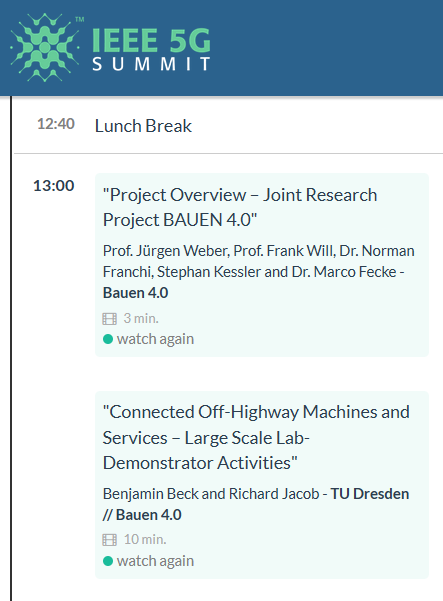
Connected Off-Highway Machines and Services - Large Scale Lab-Demonstrator Activities.
IEEE 5G++ Online Summit
Beck B.; Jacob, R.
2020, Dresden Deutschland
...
Downloads & Links
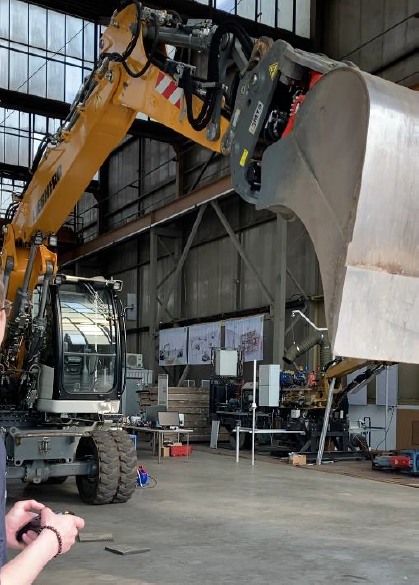
uRLLC: Remote Controlled Excavator
Ausstellung und Vorführung im Rahmen des 7th IEEE 5G++Summit
Ritz, Denis; Köhler, Simon; Jacob, Richard; Beck, Benjamin
2022, Dresden Germany
What opportunities do 5G networks offer for heavy machinery? You can discuss the answer to this question with the developers, while controlling an 18 t wheeled excavator with a game con-troller via 5G Campus net-work with low latency.[...]
Downloads & Links
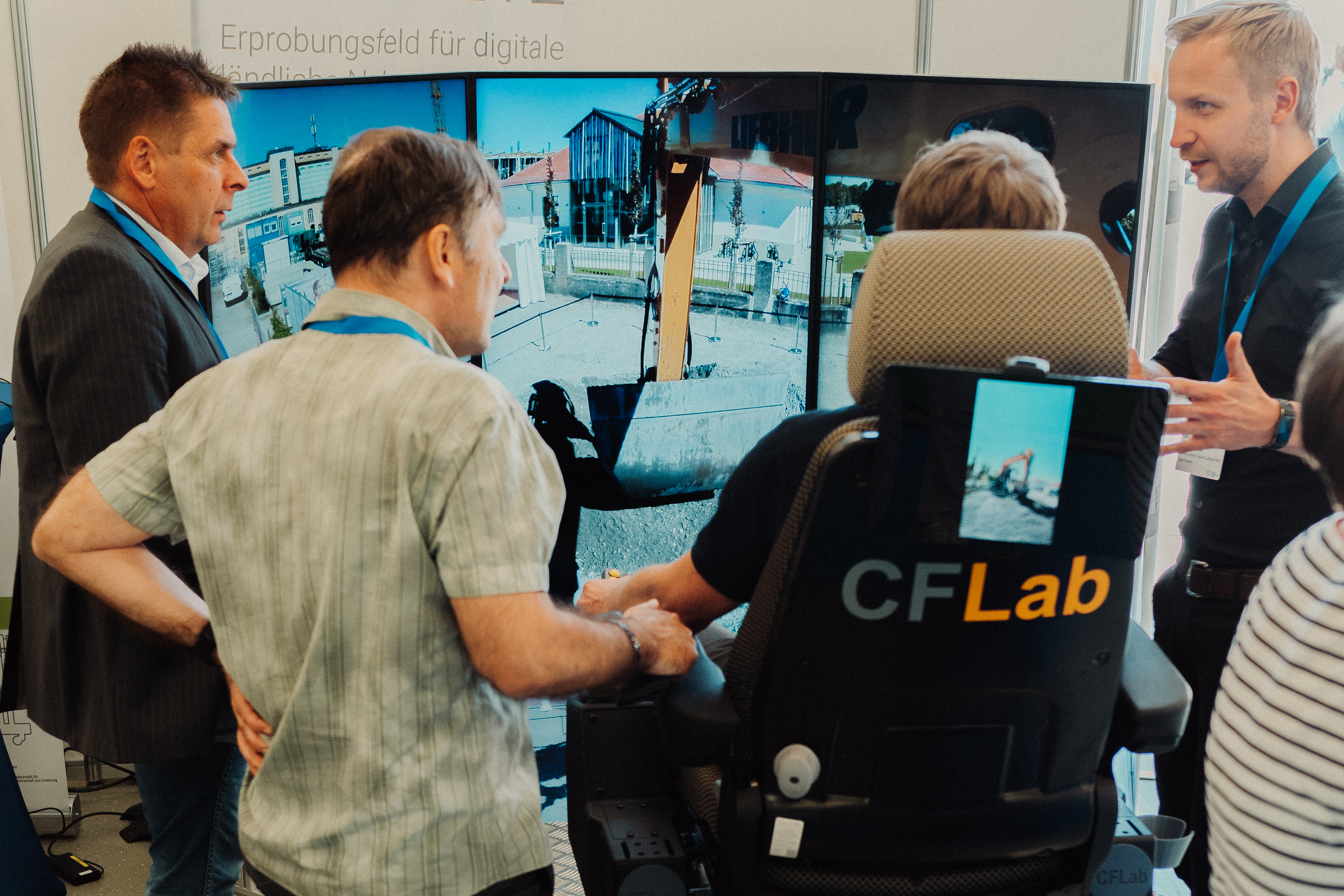
Video Remote Control for Excavators
Ausstellung und Vorführung im Rahmen des IEEE 6G Summit
Ritz, Denis; Köhler, Simon; Sitte, André; Taesch, Julian; Beck, Benjamin
2023, Dresden Germany
What does the home office look like for machine operators? How can the shortage of experienced machine operators be countered? You are welcome to discuss these questions with the CFLab team while remotely controlling an 18 t excavator via video signal. Video and Control signals, as well as sensor data for real-time 3D visualisation are provided via 5G networks (private and public). By using the industry-driven OPC-UA standard, integration is greatly simplified.[...]
Downloads & Links
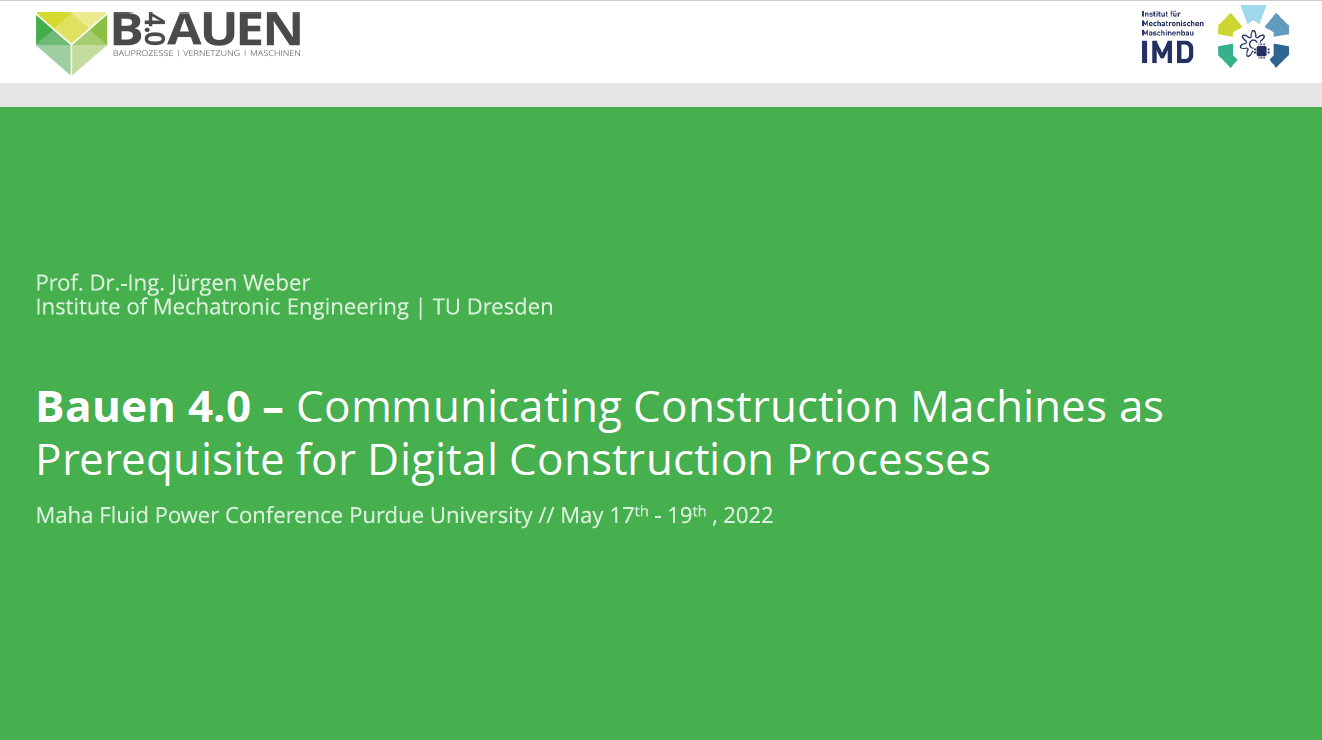
Bauen 4.0 - Communicating Construction Machines as Prerequisite for Digital Construction Processes.
Maha Fluid Power Conference
Weber, J.
2022, Purdue USA
...
Downloads & Links
5G Maschinen- und Baustellenvernetzung
Hier sehen Sie die wichtigsten Beiträge zu 5G Maschinen- und Baustellenvernetzung.

Connected Off-Highway Machines and Services - Large Scale Lab-Demonstrator Activities.
IEEE 5G++ Online Summit
Beck B.; Jacob, R.
2020, Dresden Deutschland
...
Downloads & Links

uRLLC: Remote Controlled Excavator
Ausstellung und Vorführung im Rahmen des 7th IEEE 5G++Summit
Ritz, Denis; Köhler, Simon; Jacob, Richard; Beck, Benjamin
2022, Dresden Germany
What opportunities do 5G networks offer for heavy machinery? You can discuss the answer to this question with the developers, while controlling an 18 t wheeled excavator with a game con-troller via 5G Campus net-work with low latency.[...]
Downloads & Links

Video Remote Control for Excavators
Ausstellung und Vorführung im Rahmen des IEEE 6G Summit
Ritz, Denis; Köhler, Simon; Sitte, André; Taesch, Julian; Beck, Benjamin
2023, Dresden Germany
What does the home office look like for machine operators? How can the shortage of experienced machine operators be countered? You are welcome to discuss these questions with the CFLab team while remotely controlling an 18 t excavator via video signal. Video and Control signals, as well as sensor data for real-time 3D visualisation are provided via 5G networks (private and public). By using the industry-driven OPC-UA standard, integration is greatly simplified.[...]
Downloads & Links

Bauen 4.0 - Communicating Construction Machines as Prerequisite for Digital Construction Processes.
Maha Fluid Power Conference
Weber, J.
2022, Purdue USA
...
Downloads & Links
Prozesse und Lösungen für die digitale Baustelle
Hier sehen Sie die wichtigsten Beiträge zu Prozessen und Lösungen für die digitale Baustelle.
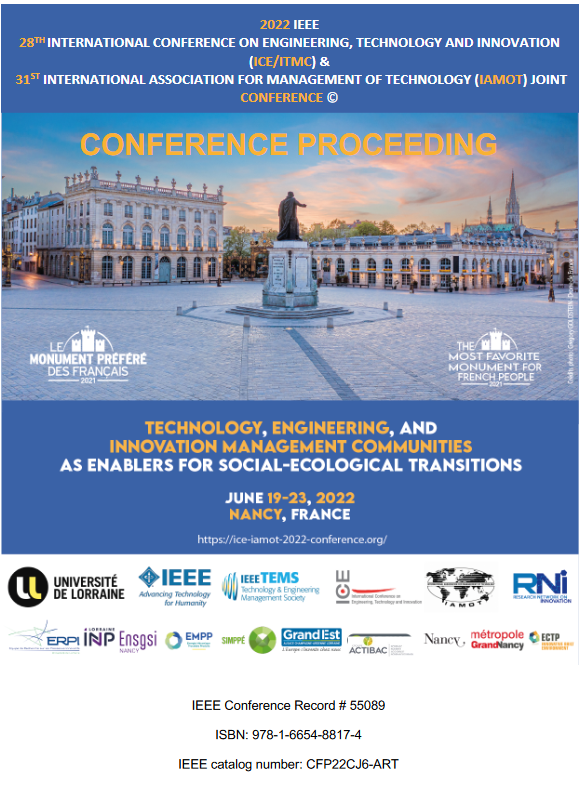
Implementation of a digital twin framework in the modular housing industry.
2022 IEEE 28th ICE/ITMC & 31st IAMOT Joint Conference IEEE
Fischer, A.; Llorens, J. R.; Cai, Z.; Wilke, M.; Kessler, S.; Fottner, J.
2022, Nantes Frankreich
The construction industry is one of the minor digitized industries, and it has been characterized by a belowaverage increase in productivity in recent decades. The modular housing sector copies the production system of the manufacturing industry to meet these deficits, which makes it a perfect example for evaluating Industry 4.0 technologies.
Downloads & Links
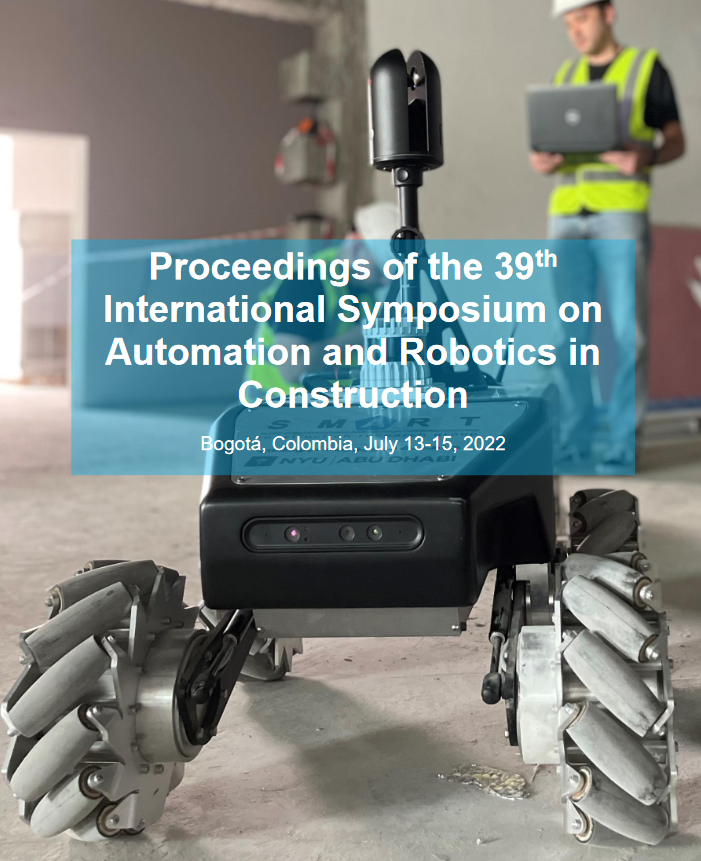
A Case Study: Conception of digitalizing prefabrication processes in the construction industry.
39th International Symposium on Automation and Robotics in Construction, ISARC
Cai, Z.; Tarfaoui, M.B.; Kessler, S.; Fottner, J.
2022, Bogota Chile
During the last few years, the importance of prefabrication and its digitalization has grown significantly in the construction industry. In this context, a German construction company intended to extend an existing warehouse application into a system that additionally monitors production time to identify the bottleneck. In this case study, a concept of digitalizing the prefabrication was proposed with the components of hardware, middleware and software.
Downloads & Links

A Case Study: Developing a Systematic Method for the Digitalization of Business Processes for SME in the Construction Industry.
Eurasian Studies in Business and Economics
Cai, Z.; Huang, Y.; Kessler, S.; Fottner, J.
2022, Springer International Publishing
A Case Study: Developing a Systematic Method for the Digitalization of Business Processes for SME in the Construction Industry. In: Eurasian Studies in Business and Economics
Downloads & Links
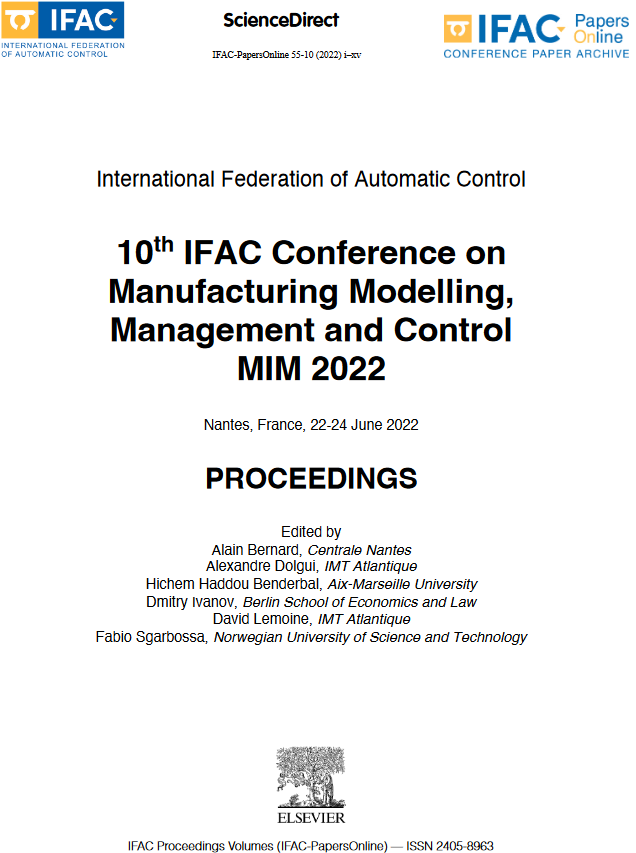
A Case Study: Digitalization of Business Processes of SMEs with Low-Code Method.
10th IFAC Conference on Manufacturing Modelling, Management and Control MIM
Cai, Z.; Huang, Y.; Kessler, S.; Fottner, J.
2022, Nantes France
Compared to large companies, small- and medium-sized enterprises (SMEs) in some critical industries, e.g. construction industry, have a lower level of digitization. One main reason is the complexity of digital transformation in the development and implementation phase.
Downloads & Links
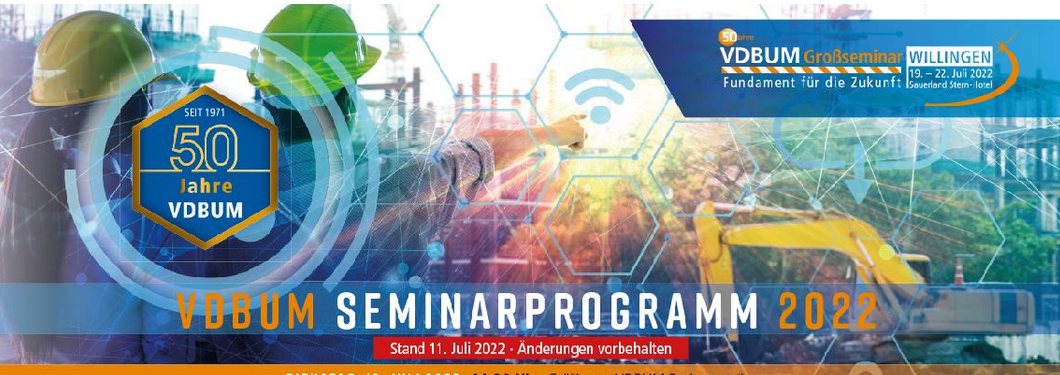
Digitalisierung der Materialflüsse in der Baulogistik auf Basis der Tracking and Tracing -Technologie
VDBUM Seminar
Cai, Z.
2022, Willingen Deutschland
...
Downloads & Links
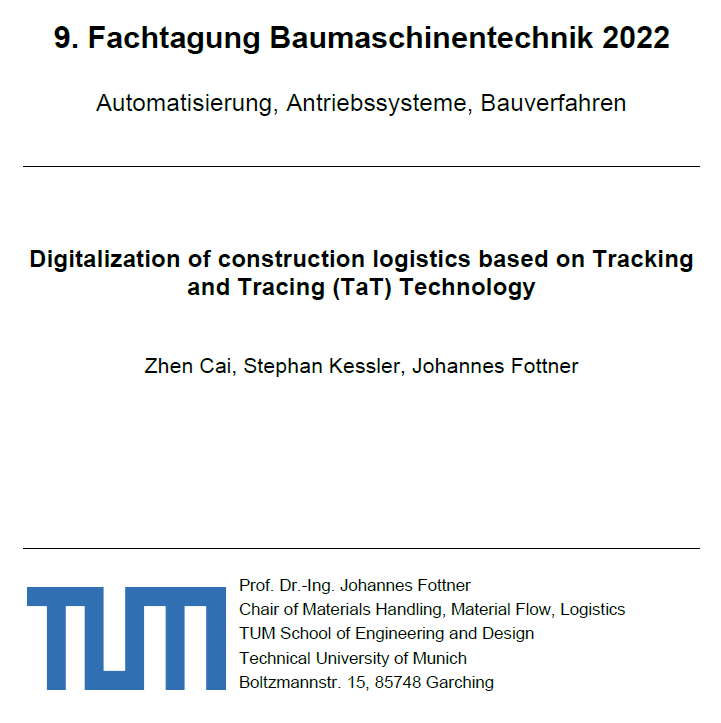
Digitalization of construction logistics based on Tracking and Tracing (TaT) Technology
9. Fachtagung Baumaschinentechnik
Cai Z.; Kessler, S.; Fottner J.
2022, Dresden Deutschland
The construction industry is an essential part of the German economy. However, unlike other manufacturing industries, the construction industry generally has low efficiency in its logistics. Tracking and tracing (TaT) is widely used solutions for digitalizing construction logistics. However, there are still problems that prevent the implementation of TaT applications. Based on this background, a systematic method is developed in this paper to implement the TaT for construction logistics. In the following paper, we explain the theoretical background and the methodology. After that, the representative results are summarized and presented. Finally, the results are evaluated, and future work is proposed.
Downloads & Links
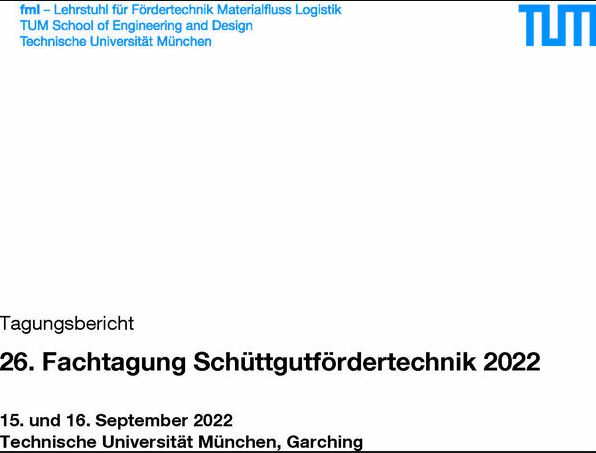
Erkennung und Volumenmessung von Schüttgütern in der Baubranche mit Deep Learning.
26. Fachtagung Schüttgutfördertechnik
Cai, Z.; Chebil, G.A.; Kessler, S.; Fottner, J.
2022, München Deutschland
...
Downloads & Links
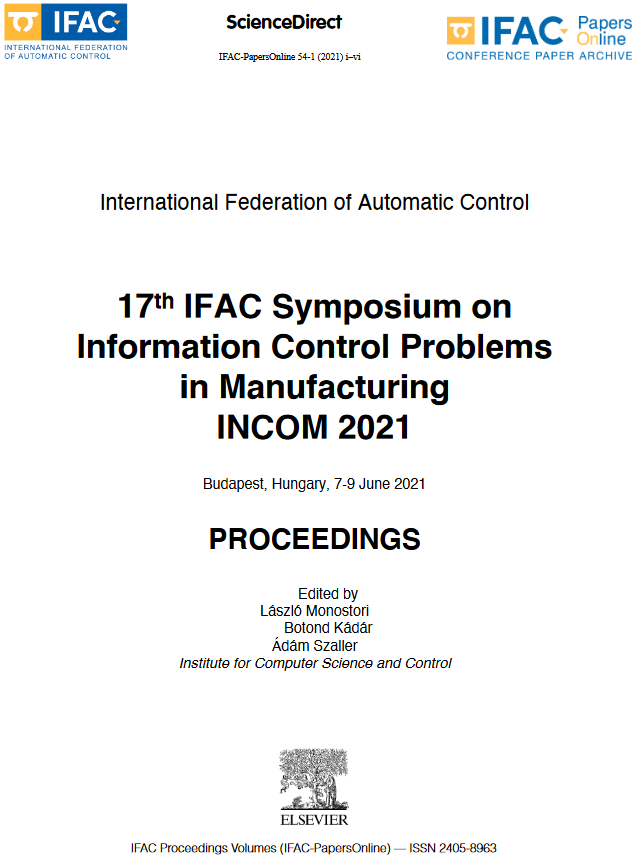
Cyclic Update of Project Scheduling by Using Telematics Data.
17th IFAC Symposium on Information Control Problems in Manufacturing
Fischer, A.; Li, Z.; Wenzler, F.; Kessler, S.; Fottner, J.
2021, Budapest Hungary
Discrete-event simulation (DES) is not really used in construction industries that require more flexibility. However, use cases can be found where DES can support the construction industries. One use case is schedule optimization. This paper presents an agent-based DES method for optimizing schedules in the construction industry taking resource-dependent process-lengths into account.
Downloads & Links

Detecting Equipment Activities by Using Machine Learning Algorithms.
17th IFAC Symposium on Information Control Problems in Manufacturing
Fischer, A.; Liang, M.; Orschlet, V.; Bi, H.; Kessler, S.; Fottner, J.:
2021, Budapest Hungary
Discrete-event simulation can serve as a tool for using equipment data to control processes and calculate alternative scenarios. For this purpose, the simulation requires knowledge of the process states on the construction site. One way using these process states automatically in the simulation is to interpret sensor data using machine learning.
Downloads & Links
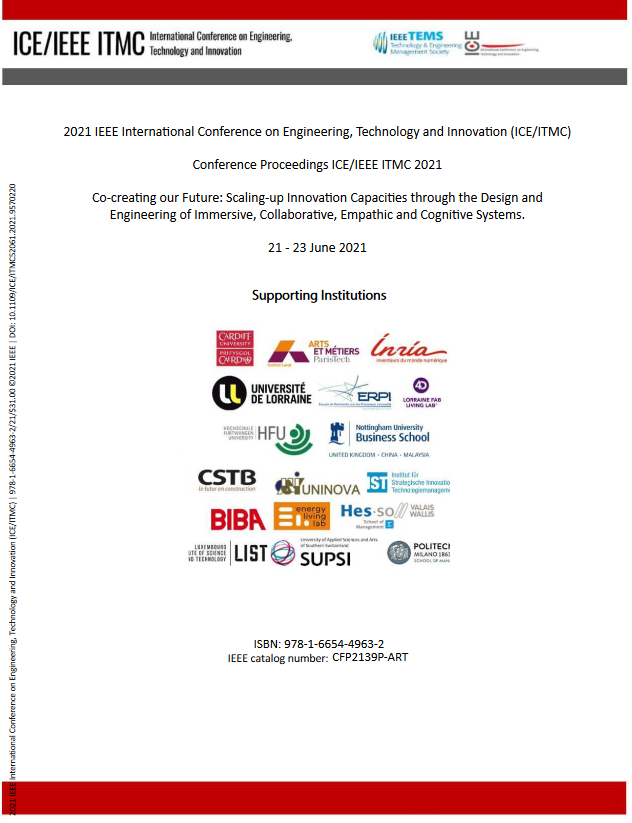
Equipment data-based activity recognition of construction machinery.
2021 IEEE International Conference on Engineering, Technology and Innovation (ICE/ITMC)
Fischer, A.; Bedrikow, A. B.; Kessler, S.; Fottner, J.
2021, Cardiff UK
Heavy equipment plays an essential role in construction projects. However, to optimize the allocation of that resource (e.g., via discrete-event simulation), the correct monitoring of the current usage of the equipment is imperative. Machine learning methods are usually based on the mounting of additional sensors such as accelerometers or gyroscopes on the equipment.
Downloads & Links

Importance of secondary processes in heavy equipment resource scheduling using hybrid simulation.
38th International Symposium on Automation and Robotics in Construction (ISARC 2021)
Fischer, A.; Li, Z.; Kessler, S.; Fottner, J.
2021, Dubai UAE
As part of the Architecture, Engineering, and Construction (AEC) industry, heavy civil engineering with its equipment-intensive processes is a current focus of discussion concerning emission reduction. Adopting Industry 4.0 technologies for resource scheduling can significantly increase the savings potential significantly. One of these digital technologies is the Discrete Event Simulation (DES). DES is a proven tool to analyze complex systems in advance but is not widely used in practice. Therefore, the presented work aims at presenting a three-part hybrid simulation framework. One part of the framework, the meso-simulation, has been evaluated using a case study in the field of pile drilling production. The work not only captures the drilling process, and therefore shows the importance of planning the secondary processes in AEC.
Downloads & Links

Integrating BIM for DES-based resource scheduling: A validation for pile drilling production.
38th International Symposium on Automation and Robotics in Construction (ISARC 2021)
Fischer, A.; Ma, S.; Kessler, S.; Fottner, J.
2021, Dubai UAE
Due To The Complexity Of Construction Projects, Building Information Modeling (BIM) Has Been Put Into Use At Present And Can Be Seen As The Data Base For The Digital Twin (DT) In Construction Industry. One Kind Of DT Is Discrete Event Simulation (DES) As A Proven Tool To Build Up Complex Systems For Calculating The Optimum Scenario. With Increasing Data Collection On-Site, BIM And DES Can Be Used Not Only For Planning But Also For Decision-Making During Execution. Today, DES Is Not Used In Practice Due To High Efforts To Set Up And Update A Model. The Paper, Therefore, Presents A Methodology For The Integration Of BIM In DES. The Focus Of The Paper Is The Heavy Civil Engineering Where Only a Few Efforts Is Put Into BIM And DES. An Overview Of Existing Standardized Data For BIM And Telematics Data Is Given. Furthermore, Currently Available IFC Software And Libraries Are Applied To Implement An Appropriate 4D Model Following The BuildingSMART Standards Of Industry Foundation Classes (IFCs). Finally, A Case Study Is Used To Validate The Method.
Downloads & Links
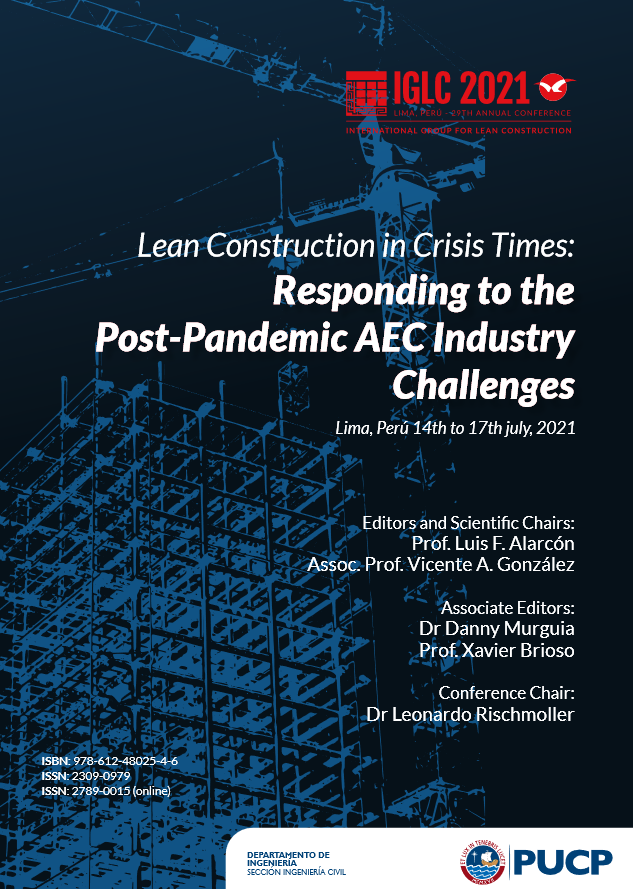
Variety in Variability in Heavy Civil Engineering.
29th Annual Conference of the International Group for Lean Construction (IGLC29)
Fischer, A.; Grimm, N.; Tommelein, I. D.; Kessler, S.; Fottner, J.
2021, Lima Peru
This paper presents a characterization of heavy civil engineering in the context of lean construction and Industry 4.0. Production characteristics of earthworks are compared with those of multi-story construction. The paper focuses on the equipment use of specialty foundation contractors and shows the variety in variability encountered in the Kelly pile drilling process, as described by industry experts. The authors identify seven sources of variability that affect production performance, classify each one by type, and then describe technologies to harness them. The paper critically examines design considerations in a production system that highly depends on equipment and highlights that advances in implementation of Industry 4.0 will demand ongoing effort in reconfiguring such systems.
Downloads & Links
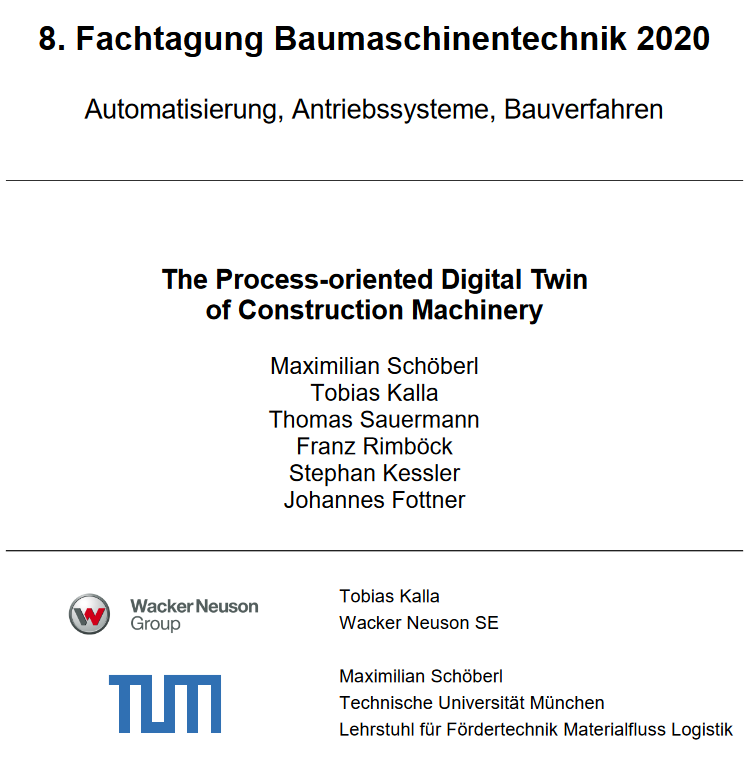
The Process-oriented Digital Twin of Construction Machinery.
8. Fachtagung Baumaschinentechnik 2020
Schöberl, M.; Kalla, T.; Sauermann, T.; Rimböck, F.; Kessler, S.; Fottner, J.
2020, Dresden Germany
Rising digitalization efforts in the construction industry come along with buzzwords like the digital twin arising in the discussion about data standards and utilization. In order to foster rigorous digitalization efforts, this paper presents a differentiated taxonomy and related definitions to above mentioned concepts
Downloads & Links
Prozesse und Lösungen für die digitale Baustelle
Hier sehen Sie die wichtigsten Beiträge zu Prozessen und Lösungen für die digitale Baustelle.
Implementation of a digital twin framework in the modular housing industry.
2022 IEEE 28th ICE/ITMC & 31st IAMOT Joint Conference IEEE
Fischer, A.; Llorens, J. R.; Cai, Z.; Wilke, M.; Kessler, S.; Fottner, J.
2022, Nantes Frankreich
The construction industry is one of the minor digitized industries, and it has been characterized by a belowaverage increase in productivity in recent decades. The modular housing sector copies the production system of the manufacturing industry to meet these deficits, which makes it a perfect example for evaluating Industry 4.0 technologies.
Downloads & Links
A Case Study: Conception of digitalizing prefabrication processes in the construction industry.
39th International Symposium on Automation and Robotics in Construction, ISARC
Cai, Z.; Tarfaoui, M.B.; Kessler, S.; Fottner, J.
2022, Bogota Chile
During the last few years, the importance of prefabrication and its digitalization has grown significantly in the construction industry. In this context, a German construction company intended to extend an existing warehouse application into a system that additionally monitors production time to identify the bottleneck. In this case study, a concept of digitalizing the prefabrication was proposed with the components of hardware, middleware and software.
Downloads & Links
A Case Study: Developing a Systematic Method for the Digitalization of Business Processes for SME in the Construction Industry.
Eurasian Studies in Business and Economics
Cai, Z.; Huang, Y.; Kessler, S.; Fottner, J.
2022, Springer International Publishing
A Case Study: Developing a Systematic Method for the Digitalization of Business Processes for SME in the Construction Industry. In: Eurasian Studies in Business and Economics
Downloads & Links
A Case Study: Digitalization of Business Processes of SMEs with Low-Code Method.
10th IFAC Conference on Manufacturing Modelling, Management and Control MIM
Cai, Z.; Huang, Y.; Kessler, S.; Fottner, J.
2022, Nantes France
Compared to large companies, small- and medium-sized enterprises (SMEs) in some critical industries, e.g. construction industry, have a lower level of digitization. One main reason is the complexity of digital transformation in the development and implementation phase.
Downloads & Links
Digitalisierung der Materialflüsse in der Baulogistik auf Basis der Tracking and Tracing -Technologie
VDBUM Seminar
Cai, Z.
2022, Willingen Deutschland
...
Downloads & Links
Digitalization of construction logistics based on Tracking and Tracing (TaT) Technology
9. Fachtagung Baumaschinentechnik
Cai Z.; Kessler, S.; Fottner J.
2022, Dresden Deutschland
The construction industry is an essential part of the German economy. However, unlike other manufacturing industries, the construction industry generally has low efficiency in its logistics. Tracking and tracing (TaT) is widely used solutions for digitalizing construction logistics. However, there are still problems that prevent the implementation of TaT applications. Based on this background, a systematic method is developed in this paper to implement the TaT for construction logistics. In the following paper, we explain the theoretical background and the methodology. After that, the representative results are summarized and presented. Finally, the results are evaluated, and future work is proposed.
Downloads & Links
Erkennung und Volumenmessung von Schüttgütern in der Baubranche mit Deep Learning.
26. Fachtagung Schüttgutfördertechnik
Cai, Z.; Chebil, G.A.; Kessler, S.; Fottner, J.
2022, München Deutschland
...
Downloads & Links
Cyclic Update of Project Scheduling by Using Telematics Data.
17th IFAC Symposium on Information Control Problems in Manufacturing
Fischer, A.; Li, Z.; Wenzler, F.; Kessler, S.; Fottner, J.
2021, Budapest Hungary
Discrete-event simulation (DES) is not really used in construction industries that require more flexibility. However, use cases can be found where DES can support the construction industries. One use case is schedule optimization. This paper presents an agent-based DES method for optimizing schedules in the construction industry taking resource-dependent process-lengths into account.
Downloads & Links
Detecting Equipment Activities by Using Machine Learning Algorithms.
17th IFAC Symposium on Information Control Problems in Manufacturing
Fischer, A.; Liang, M.; Orschlet, V.; Bi, H.; Kessler, S.; Fottner, J.:
2021, Budapest Hungary
Discrete-event simulation can serve as a tool for using equipment data to control processes and calculate alternative scenarios. For this purpose, the simulation requires knowledge of the process states on the construction site. One way using these process states automatically in the simulation is to interpret sensor data using machine learning.
Downloads & Links
Equipment data-based activity recognition of construction machinery.
2021 IEEE International Conference on Engineering, Technology and Innovation (ICE/ITMC)
Fischer, A.; Bedrikow, A. B.; Kessler, S.; Fottner, J.
2021, Cardiff UK
Heavy equipment plays an essential role in construction projects. However, to optimize the allocation of that resource (e.g., via discrete-event simulation), the correct monitoring of the current usage of the equipment is imperative. Machine learning methods are usually based on the mounting of additional sensors such as accelerometers or gyroscopes on the equipment.
Downloads & Links
Importance of secondary processes in heavy equipment resource scheduling using hybrid simulation.
38th International Symposium on Automation and Robotics in Construction (ISARC 2021)
Fischer, A.; Li, Z.; Kessler, S.; Fottner, J.
2021, Dubai UAE
As part of the Architecture, Engineering, and Construction (AEC) industry, heavy civil engineering with its equipment-intensive processes is a current focus of discussion concerning emission reduction. Adopting Industry 4.0 technologies for resource scheduling can significantly increase the savings potential significantly. One of these digital technologies is the Discrete Event Simulation (DES). DES is a proven tool to analyze complex systems in advance but is not widely used in practice. Therefore, the presented work aims at presenting a three-part hybrid simulation framework. One part of the framework, the meso-simulation, has been evaluated using a case study in the field of pile drilling production. The work not only captures the drilling process, and therefore shows the importance of planning the secondary processes in AEC.
Downloads & Links
Integrating BIM for DES-based resource scheduling: A validation for pile drilling production.
38th International Symposium on Automation and Robotics in Construction (ISARC 2021)
Fischer, A.; Ma, S.; Kessler, S.; Fottner, J.
2021, Dubai UAE
Due To The Complexity Of Construction Projects, Building Information Modeling (BIM) Has Been Put Into Use At Present And Can Be Seen As The Data Base For The Digital Twin (DT) In Construction Industry. One Kind Of DT Is Discrete Event Simulation (DES) As A Proven Tool To Build Up Complex Systems For Calculating The Optimum Scenario. With Increasing Data Collection On-Site, BIM And DES Can Be Used Not Only For Planning But Also For Decision-Making During Execution. Today, DES Is Not Used In Practice Due To High Efforts To Set Up And Update A Model. The Paper, Therefore, Presents A Methodology For The Integration Of BIM In DES. The Focus Of The Paper Is The Heavy Civil Engineering Where Only a Few Efforts Is Put Into BIM And DES. An Overview Of Existing Standardized Data For BIM And Telematics Data Is Given. Furthermore, Currently Available IFC Software And Libraries Are Applied To Implement An Appropriate 4D Model Following The BuildingSMART Standards Of Industry Foundation Classes (IFCs). Finally, A Case Study Is Used To Validate The Method.
Downloads & Links
Variety in Variability in Heavy Civil Engineering.
29th Annual Conference of the International Group for Lean Construction (IGLC29)
Fischer, A.; Grimm, N.; Tommelein, I. D.; Kessler, S.; Fottner, J.
2021, Lima Peru
This paper presents a characterization of heavy civil engineering in the context of lean construction and Industry 4.0. Production characteristics of earthworks are compared with those of multi-story construction. The paper focuses on the equipment use of specialty foundation contractors and shows the variety in variability encountered in the Kelly pile drilling process, as described by industry experts. The authors identify seven sources of variability that affect production performance, classify each one by type, and then describe technologies to harness them. The paper critically examines design considerations in a production system that highly depends on equipment and highlights that advances in implementation of Industry 4.0 will demand ongoing effort in reconfiguring such systems.
Downloads & Links
The Process-oriented Digital Twin of Construction Machinery.
8. Fachtagung Baumaschinentechnik 2020
Schöberl, M.; Kalla, T.; Sauermann, T.; Rimböck, F.; Kessler, S.; Fottner, J.
2020, Dresden Germany
Rising digitalization efforts in the construction industry come along with buzzwords like the digital twin arising in the discussion about data standards and utilization. In order to foster rigorous digitalization efforts, this paper presents a differentiated taxonomy and related definitions to above mentioned concepts
Downloads & Links
Weitere Impressionen vom Projekt Bauen 4.0: